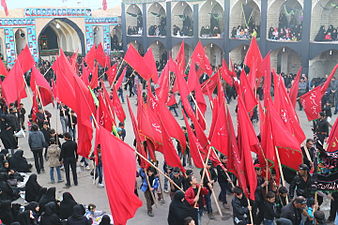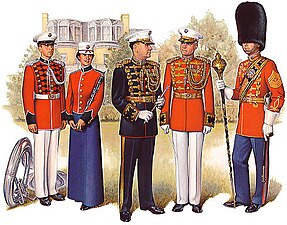Red
This article may be too long to read and navigate comfortably. (March 2019) |
| Red | |
|---|---|
| Spectral coordinates | |
| Wavelength | approx. 625–740 [1] nm |
| Frequency | ~480–400 THz |
| Hex triplet | #FF0000 |
| sRGBB (r, g, b) | (255, 0, 0) |
| HSV (h, s, v) | (0°, 100%, 100%) |
| CIELChuv (L, C, h) | (53, 179, 12°) |
| Source | X11 |
| B: Normalized to [0–255] (byte) | |
Red is the color at the end of the visible spectrum of light, next to orange and opposite violet. It has a dominant wavelength of approximately 625–740 nanometres.[1] It is a primary color in the RGB color model and the CMYK color model, and is the complementary color of cyan. Reds range from the brilliant yellow-tinged scarlet and vermillion to bluish-red crimson, and vary in shade from the pale red pink to the dark red burgundy.[2] The red sky at sunset results from Rayleigh scattering, while the red color of the Grand Canyon and other geological features is caused by hematite or red ochre, both forms of iron oxide. Iron oxide also gives the red color to the planet Mars. The red color of blood comes from the protein hemoglobin, while ripe strawberries, red apples and reddish autumn leaves are colored by anthocyanins.[3]
Red pigment made from ochre was one of the first colors used in prehistoric art. The Ancient Egyptians and Mayans colored their faces red in ceremonies; Roman generals had their bodies colored red to celebrate victories. It was also an important color in China, where it was used to color early pottery and later the gates and walls of palaces.[4]: 60–61 In the Renaissance, the brilliant red costumes for the nobility and wealthy were dyed with kermes and cochineal. The 19th century brought the introduction of the first synthetic red dyes, which replaced the traditional dyes. Red also became the color of revolution; Soviet Russia adopted a red flag following the Bolshevik Revolution in 1917, later followed by China, Vietnam, and other communist countries.
Since red is the color of blood, it has historically been associated with sacrifice, danger and courage. Modern surveys in Europe and the United States show red is also the color most commonly associated with heat, activity, passion, sexuality, anger, love and joy. In China, India and many other Asian countries it is the color of symbolizing happiness and good fortune.[5]: 39–63
Shades and variations
-
Pink is a pale shade of red. Cherry blossoms in the Tsutsujigaoka Park, Sendai, Miyagi, Japan.
-
Crimson is a strong, deep red containing a little blue. The emblem of Harvard University.
In science and nature
Seeing red

The human eye sees red when it looks at light with a wavelength between approximately 625 and 740 nanometers.[1] It is a primary color in the RGB color model and the light just past this range is called infrared, or below red, and cannot be seen by human eyes, although it can be sensed as heat.[8] In the language of optics, red is the color evoked by light that stimulates neither the S or the M (short and medium wavelength) cone cells of the retina, combined with a fading stimulation of the L (long-wavelength) cone cells.[9]
Primates can distinguish the full range of the colors of the spectrum visible to humans, but many kinds of mammals, such as dogs and cattle, have dichromacy, which means they can see blues and yellows, but cannot distinguish red and green (both are seen as gray). Bulls, for instance, cannot see the red color of the cape of a bullfighter, but they are agitated by its movement.[10] (See color vision).
One theory for why primates developed sensitivity to red is that it allowed ripe fruit to be distinguished from unripe fruit and inedible vegetation.[11] This may have driven further adaptations by species taking advantage of this new ability, such as the emergence of red faces.[12]
Red light is used to help adapt night vision in low-light or night time, as the rod cells in the human eye are not sensitive to red.[13][14]
Red illumination was (and sometimes still is) used as a safelight while working in a darkroom as it does not expose most photographic paper and some films.[15] Today modern darkrooms usually use an amber safelight.
In color theory and on a computer screen
On the color wheel long used by painters, and in traditional color theory, red is one of the three primary colors, along with blue and yellow. Painters in the Renaissance mixed red and blue to make violet: Cennino Cennini, in his 15th-century manual on painting, wrote, "If you want to make a lovely violet colour, take fine lac [red lake], ultramarine blue (the same amount of the one as of the other) with a binder" he noted that it could also be made by mixing blue indigo and red hematite.[16]
In modern color theory, also known as the RGB color model, red, green and blue are additive primary colors. Red, green and blue light combined together makes white light, and these three colors, combined in different mixtures, can produce nearly any other color. This is the principle that is used to make all of the colors on your computer screen and your television. For example, magenta on a computer screen is made by a similar formula to that used by Cennino Cennini in the Renaissance to make violet, but using additive colors and light instead of pigment: it is created by combining red and blue light at equal intensity on a black screen. Violet is made on a computer screen in a similar way, but with a greater amount of blue light and less red light.[17]
(See Web colors and RGB color model)
-
In a traditional color wheel from 1708, red, yellow and blue are primary colors. Red and yellow make orange, red and blue make violet.
-
In modern color theory, red, green and blue are the additive primary colors, and together they make white. A combination of red, green and blue light in varying proportions makes all the colors on your computer screen and television screen.
-
Tiny Red, green and blue sub-pixels (enlarged on left side of image) create the colors you see on your computer screen and TV.
Color of sunset

As a ray of white sunlight travels through the atmosphere to the eye, some of the colors are scattered out of the beam by air molecules and airborne particles due to Rayleigh scattering, changing the final color of the beam that is seen. Colors with a shorter wavelength, such as blue and green, scatter more strongly, and are removed from the light that finally reaches the eye.[18] At sunrise and sunset, when the path of the sunlight through the atmosphere to the eye is longest, the blue and green components are removed almost completely, leaving the longer wavelength orange and red light. The remaining reddened sunlight can also be scattered by cloud droplets and other relatively large particles, which give the sky above the horizon its red glow.[19]
Lasers
Lasers emitting in the red region of the spectrum have been available since the invention of the ruby laser in 1960. In 1962 the red helium–neon laser was invented,[20] and these two types of lasers were widely used in many scientific applications including holography, and in education. Red helium–neon lasers were used commercially in LaserDisc players. The use of red laser diodes became widespread with the commercial success of modern DVD players, which use a 660 nm laser diode technology. Today, red and red-orange laser diodes are widely available to the public in the form of extremely inexpensive laser pointers. Portable, high-powered versions are also available for various applications.[21] More recently, 671 nm diode-pumped solid state (DPSS) lasers have been introduced to the market for all-DPSS laser display systems, particle image velocimetry, Raman spectroscopy, and holography.[22]
Red's wavelength has been an important factor in laser technologies; red lasers, used in early compact disc technologies, are being replaced by blue lasers, as red's longer wavelength causes the laser's recordings to take up more space on the disc than would blue-laser recordings.[23]
Astronomy
- Mars is called the Red Planet because of the reddish color imparted to its surface by the abundant iron oxide present there.[24]
- Astronomical objects that are moving away from the observer exhibit a Doppler red shift.
- Jupiter's surface displays a Great Red Spot caused by an oval-shaped mega storm south of the planet's equator.[25]
- Red giants are stars that have exhausted the supply of hydrogen in their cores and switched to thermonuclear fusion of hydrogen in a shell that surrounds its core. They have radii tens to hundreds of times larger than that of the Sun. However, their outer envelope is much lower in temperature, giving them an orange hue. Despite the lower energy density of their envelope, red giants are many times more luminous than the Sun due to their large size.
- Red supergiants like Antares, Betelgeuse, VY Canis Majoris and UY Scuti, one of the biggest stars in the Universe, are the biggest variety of red giants. They are huge in size, with radii 200 to 2600 times greater than our Sun, but relatively cool in temperature (3000–4500 K), causing their distinct red tint. Because they are shrinking rapidly in size, they are surrounded by an envelope or skin much bigger than the star itself. The envelope of Betelgeuse is 250 times bigger than the star inside.
- A red dwarf is a small and relatively cool star, which has a mass of less than half that of the Sun and a surface temperature of less than 4,000 K. Red dwarfs are by far the most common type of star in the Galaxy, but due to their low luminosity, from Earth, none are visible to the naked eye.[26]
-
Mars appears to be red because of iron oxide on its surface.
-
Artist's impression of a red dwarf, a small, relatively cool star that appears red due to its temperature
Fire
- Fire is often shown as red in art, but flames are usually yellow, orange or blue. Coals are in the red spectrum, as are most burning items. Some elements exhibit a red color when burned: calcium, for example, produces a brick-red when combusted.[27]
-
Red is commonly associated with flames and fire, but flames are almost always yellow, orange or blue. Coals are in the red spectrum, as are most burning items.
Pigments and dyes
-
Hematite, or iron ore, is the source of the red color of red ochre.
-
Red ochre cliffs near Roussillon in France. Red ochre is composed of clay tinted with hematite. Ochre was the first pigment used by man in prehistoric cave paintings.
-
Vermilion pigment, made from cinnabar. This was the pigment used in the murals of Pompeii and to color Chinese lacquerware beginning in the Song dynasty.
-
Despite its yellow greenish flower, the roots of the Rubia tinctorum, or madder plant, produced the most common red dye used from ancient times until the 19th century.
-
Red lead, also known as minium, has been used since the time of the ancient Greeks. Chemically it is known as lead tetroxide. The Romans prepared it by the roasting of lead white pigment. It was commonly used in the Middle Ages for the headings and decoration of illuminated manuscripts.
-
Dragon's blood is a bright red resin that is obtained from different species of a number of distinct plant genera: Croton, Dracaena, Daemonorops, Calamus rotang and Pterocarpus. The red resin was used in ancient times as a medicine, incense, dye and varnish for making violins in Italy.
-
Extract of carmine, made by crushing cochineal and other scale insects which feed on the sap of live oak trees. Also called kermes, it was used from the Middle Ages until the 19th century to make crimson dye. Now it is used as a coloring for yoghurt and other food products.
-
The Sappanwood tree, native to India, Malaysia and Sri Lanka, and later the related Brazilwood tree (shown here), from the coast of South America, were the source of a popular red pigment and dye called brazilin. The red wood was ground to powder and mixed with an alkaline solution. The brazilwood gave its name to the nation of Brazil.
-
Alizarin was the first synthetic red dye, created by German chemists in 1868. It duplicated the colorant in the madder plant, but was cheaper and longer lasting. After its introduction, the production of natural dyes from the madder plant virtually ceased.
Red lac, red lake and crimson lake

Red lac, also called red lake, crimson lake or carmine lake, was an important red pigment in Renaissance and Baroque art. Since it was translucent, thin layers of red lac were built up or glazed over a more opaque dark color to create a particularly deep and vivid color.
Unlike vermilion or red ochre, made from minerals, red lake pigments are made by mixing organic dyes, made from insects or plants, with white chalk or alum. Red lac was made from the gum lac, the dark red resinous substance secreted by various scale insects, particularly the Laccifer lacca from India.[28] Carmine lake was made from the cochineal insect from Central and South America, Kermes lake came from a different scale insect, kermes vermilio, which thrived on oak trees around the Mediterranean. Other red lakes were made from the rose madder plant and from the brazilwood tree.
Red lake pigments were an important part of the palette of 16th-century Venetian painters, particularly Titian, but they were used in all periods.[29] Since the red lakes were made from organic dyes, they tended to be fugitive, becoming unstable and fading when exposed to sunlight.
Food coloring
The most common synthetic food coloring today is Allura Red AC, a red azo dye that goes by several names including: Allura Red, Food Red 17, C.I. 16035, FD&C Red 40,[30][31] It was originally manufactured from coal tar, but now is mostly made from petroleum.
In Europe, Allura Red AC is not recommended for consumption by children. It is banned in Denmark, Belgium, France and Switzerland, and was also banned in Sweden until the country joined the European Union in 1994.[32] The European Union approves Allura Red AC as a food colorant, but EU countries' local laws banning food colorants are preserved.[33]
In the United States, Allura Red AC is approved by the Food and Drug Administration (FDA) for use in cosmetics, drugs, and food. It is used in some tattoo inks and is used in many products, such as soft drinks, children's medications, and cotton candy. On June 30, 2010, the Center for Science in the Public Interest (CSPI) called for the FDA to ban Red 40.[34]
Because of public concerns about possible health risks associated with synthetic dyes, many companies have switched to using natural pigments such as carmine, made from crushing the tiny female cochineal insect. This insect, originating in Mexico and Central America, was used to make the brilliant scarlet dyes of the European Renaissance.
Autumn leaves
The red of autumn leaves is produced by pigments called anthocyanins. They are not present in the leaf throughout the growing season, but are actively produced towards the end of summer.[3] They develop in late summer in the sap of the cells of the leaf, and this development is the result of complex interactions of many influences—both inside and outside the plant. Their formation depends on the breakdown of sugars in the presence of bright light as the level of phosphate in the leaf is reduced.[35]
During the summer growing season, phosphate is at a high level. It has a vital role in the breakdown of the sugars manufactured by chlorophyll. But in the fall, phosphate, along with the other chemicals and nutrients, moves out of the leaf into the stem of the plant. When this happens, the sugar-breakdown process changes, leading to the production of anthocyanin pigments. The brighter the light during this period, the greater the production of anthocyanins and the more brilliant the resulting color display. When the days of autumn are bright and cool, and the nights are chilly but not freezing, the brightest colorations usually develop.
Anthocyanins temporarily color the edges of some of the very young leaves as they unfold from the buds in early spring. They also give the familiar color to such common fruits as cranberries, red apples, blueberries, cherries, raspberries, and plums.
Anthocyanins are present in about 10% of tree species in temperate regions, although in certain areas—a famous example being New England—up to 70% of tree species may produce the pigment.[3] In autumn forests they appear vivid in the maples, oaks, sourwood, sweetgums, dogwoods, tupelos, cherry trees and persimmons. These same pigments often combine with the carotenoids' colors to create the deeper orange, fiery reds, and bronzes typical of many hardwood species. (See Autumn leaf color).
Blood and other reds in nature
Oxygenated blood is red due to the presence of oxygenated hemoglobin that contains iron molecules, with the iron components reflecting red light.[36][37] Red meat gets its color from the iron found in the myoglobin and hemoglobin in the muscles and residual blood.[38]
Plants like apples, strawberries, cherries, tomatoes, peppers, and pomegranates are often colored by forms of carotenoids, red pigments that also assist photosynthesis.[39]
- When used to describe natural animal coloration, "red" usually refers to a brownish, reddish-brown or ginger color. In this sense it is used to describe coat colors of reddish-brown cattle and dogs, and in the names of various animal species or breeds such as red fox, red squirrel, red deer, European robin, red grouse, red knot, redstart, redwing, red setter, Red Devon cattle, etc. This reddish-brown color is also meant when using the terms red ochre and red hair.
- The red herring dragged across a trail to destroy the scent gets its color from the heavy salting and slow smoking of the fish, which results in a warm, brown color.
- When used for flowers, red often refers to purplish (red deadnettle, red clover, red helleborine) or pink (red campion, red valerian) colors.
-
Red blood cell agar. Blood appears red due to the iron molecules in blood cells.
-
A red setter or Irish setter
-
A pair of European red foxes.
-
The European robin or robin redbreast
-
A cooked lobster
Hair color

Red hair occurs naturally on approximately 1–2% of the human population.[40] It occurs more frequently (2–6%) in people of northern or western European ancestry, and less frequently in other populations. Red hair appears in people with two copies of a recessive gene on chromosome 16 which causes a mutation in the MC1R protein.[41]
Red hair varies from a deep burgundy through burnt orange to bright copper. It is characterized by high levels of the reddish pigment pheomelanin (which also accounts for the red color of the lips) and relatively low levels of the dark pigment eumelanin. The term redhead (originally redd hede) has been in use since at least 1510.[42] Cultural reactions have varied from ridicule to admiration; many common stereotypes exist regarding redheads and they are often portrayed as fiery-tempered.
In animal and human behavior
Red is associated with dominance in a number of animal species.[43] For example, in mandrills, red coloration of the face is greatest in alpha males, increasingly less prominent in lower ranking subordinates, and directly correlated with levels of testosterone.[44] Red can also affect the perception of dominance by others, leading to significant differences in mortality, reproductive success and parental investment between individuals displaying red and those not.[45] In humans, wearing red has been linked with increased performance in competitions, including professional sport[46][47] and multiplayer video games.[48] Controlled tests have demonstrated that wearing red does not increase performance or levels of testosterone during exercise, so the effect is likely to be produced by perceived rather than actual performance.[49] Judges of tae kwon do have been shown to favor competitors wearing red protective gear over blue,[50] and, when asked, a significant majority of people say that red abstract shapes are more "dominant", "aggressive", and "likely to win a physical competition" than blue shapes.[43] In contrast to its positive effect in physical competition and dominance behavior, exposure to red decreases performance in cognitive tasks[51] and elicits aversion in psychological tests where subjects are placed in an "achievement" context (e.g. taking an IQ test).[52]
History and art
Prehistory
Inside cave 13B at Pinnacle Point, an archeological site found on the coast of South Africa, paleoanthropologists in 2000 found evidence that, between 170,000 and 40,000 years ago, Late Stone Age people were scraping and grinding ochre, a clay colored red by iron oxide, probably with the intention of using it to color their bodies.[53]
Red hematite powder was also found scattered around the remains at a grave site in a Zhoukoudian cave complex near Beijing. The site has evidence of habitation as early as 700,000 years ago. The hematite might have been used to symbolize blood in an offering to the dead.[4]: 4
Red, black and white were the first colors used by artists in the Upper Paleolithic age, probably because natural pigments such as red ochre and iron oxide were readily available where early people lived. Madder, a plant whose root could be made into a red dye, grew widely in Europe, Africa and Asia.[54] The cave of Altamira in Spain has a painting of a bison colored with red ochre that dates to between 15,000 and 16,500 BC.
A red dye called Kermes was made beginning in the Neolithic Period by drying and then crushing the bodies of the females of a tiny scale insect in the genus Kermes, primarily Kermes vermilio. The insects live on the sap of certain trees, especially Kermes oak trees near the Mediterranean region. Jars of kermes have been found in a Neolithic cave-burial at Adaoutse, Bouches-du-Rhône.[55]: 230–31 Kermes from oak trees was later used by Romans, who imported it from Spain. A different variety of dye was made from Porphyrophora hamelii (Armenian cochineal) scale insects that lived on the roots and stems of certain herbs. It was mentioned in texts as early as the 8th century BC, and it was used by the ancient Assyrians and Persians.[56]: 45
Kermes is also mentioned in the Bible. In the Book of Exodus, God instructs Moses to have the Israelites bring him an offering including cloth "of blue, and purple, and scarlet."[57] The term used for scarlet in the 4th-century Latin Vulgate version of the Bible passage is coccumque bis tinctum, meaning "colored twice with coccus." Coccus, from the ancient Greek Kokkos, means a tiny grain and is the term that was used in ancient times for the Kermes vermilio insect used to make the Kermes dye.[58] This was also the origin of the expression "dyed in the grain."[59]
Ancient history
In ancient Egypt, red was associated with life, health, and victory. Egyptians would color themselves with red ochre during celebrations.[60] Egyptian women used red ochre as a cosmetic to redden cheeks and lips[61] and also used henna to color their hair and paint their nails.[62]
But, like many colors, it also had a negative association, with heat, destruction and evil. A prayer to god Isis states: "Oh Isis, protect me from all things evil and red."[5]: 45 The ancient Egyptians began manufacturing pigments in about 4000 BC. Red ochre was widely used as a pigment for wall paintings, particularly as the skin color of men. An ivory painter's palette found inside the tomb of King Tutankhamun had small compartments with pigments of red ochre and five other colors. The Egyptians used the root of the rubia, or madder plant, to make a dye, later known as alizarin, and also used it as a pigment, which became known as madder lake, alizarin or alizarin crimson.[63]
In Ancient China, artisans were making red and black painted pottery as early as the Yangshao Culture period (5000–3000 BC). A red-painted wooden bowl was found at a Neolithic site in Yuyao, Zhejiang. Other red-painted ceremonial objects have been found at other sites dating to the Spring and Autumn period (770–221 BC).[4]
During the Han dynasty (200 BC–200 AD) Chinese craftsmen made a red pigment, lead tetroxide, which they called ch-ien tan, by heating lead white pigment. Like the Egyptians, they made a red dye from the madder plant to color silk fabric for gowns and used pigments colored with madder to make red lacquerware.
Red lead or Lead tetroxide pigment was widely used as the red in Persian and Indian miniature paintings as well as in European art, where it was called minium.[63]
In India, the rubia plant has been used to make dye since ancient times. A piece of cotton dyed with rubia dated to the third millennium BC was found at an archaeological site at Mohenjo-daro.[64] It has been used by Indian monks and hermits for centuries to dye their robes.
The early inhabitants of America had their own vivid crimson dye, made from the cochineal, an insect of the same family as the Kermes of Europe and the Middle East, which feeds on the Opuntia, or prickly pear cactus plant. Red-dyed textiles from the Paracas culture (800–100 BC) have been found in tombs in Peru.[65]
Red also featured in the burials of royalty in the Maya city-states. In the Tomb of the Red Queen inside Temple XIII in the ruined Maya city of Palenque (600–700 AD), the skeleton and ceremonial items of a noble woman were completely covered with bright red powder made from cinnabar.[66]
-
Image of a human hand created with red ochre in Pech Merle cave, France (Gravettian era, 25,000 BC).
-
Image of a bison from the cave of Altamira in Spain, painted with red ochre between 15,000 and 16,500 BC.
-
Painted red and black bowl from the Yangshao culture period in China (4500 BC), in the National Museum of Beijing
-
Chinese lacquerware from the Han Dynasty (200 BC–200 AD)
In ancient Greece and the Minoan civilization of ancient Crete, red was widely used in murals and in the polychrome decoration of temples and palaces. The Greeks began using red lead as a pigment.
Romans wore togas with red stripes on holidays, and the bride at a wedding wore a red shawl, called a flammeum.[5]: 46 Red was used to color statues and the skin of gladiators. Red was also the color associated with army; Roman soldiers wore red tunics, and officers wore a cloak called a paludamentum which, depending upon the quality of the dye, could be crimson, scarlet or purple. In Roman mythology red is associated with the god of war, Mars.[67] The vexilloid of the Roman Empire had a red background with the letters SPQR in gold. A Roman general receiving a triumph had his entire body painted red in honor of his achievement.[68]
The Romans liked bright colors, and many Roman villas were decorated with vivid red murals. The pigment used for many of the murals was called vermilion, and it came from the mineral cinnabar, a common ore of mercury. It was one of the finest reds of ancient times – the paintings have retained their brightness for more than twenty centuries. The source of cinnabar for the Romans was a group of mines near Almadén, southwest of Madrid, in Spain. Working in the mines was extremely dangerous, since mercury is highly toxic; the miners were slaves or prisoners, and being sent to the cinnabar mines was a virtual death sentence.[69]
-
A restored mural, called The Prince of Lilies, from the Bronze Age Palace of Minos at Knossos on Crete
-
Etruscan dancers in the Tomb of the Triclinium (470 BC)
-
A fresco in the House of the Vettii in Pompeii, from about 62 AD. It was buried by the eruption of Vesuvius in 79 AD and preserved.
-
Roman wall painting showing a dye shop, Pompeii (40 BC). Dyed fabrics have been hung up to dry.
Postclassical history
In Europe
After the fall of the Western Roman Empire, red was adopted as a color of majesty and authority by the Byzantine Empire, the princes of Europe, and the Roman Catholic Church. It also played an important part in the rituals of the Catholic Church, symbolizing the blood of Christ and the Christian martyrs.[70][71]
Red was the color of the banner of the Byzantine emperors. In Western Europe, Emperor Charlemagne painted his palace red as a very visible symbol of his authority, and wore red shoes at his coronation.[56]: 36–37 Kings, princes and, beginning in 1295, Roman Catholic cardinals began to wear red colored habitus. When Abbe Suger rebuilt Saint Denis Basilica outside Paris in the early 12th century, he added stained glass windows colored blue cobalt glass and red glass tinted with copper. Together they flooded the basilica with a mystical light. Soon stained glass windows were being added to cathedrals all across France, England and Germany. In medieval painting red was used to attract attention to the most important figures; both Christ and the Virgin Mary were commonly painted wearing red mantles.
Red clothing was a sign of status and wealth. It was worn not only by cardinals and princes,[72] but also by merchants, artisans and townspeople, particularly on holidays or special occasions. Red dye for the clothing of ordinary people was made from the roots of the rubia tinctorum, the madder plant. This color leaned toward brick-red, and faded easily in the sun or during washing. The wealthy and aristocrats wore scarlet clothing dyed with kermes, or carmine, made from the carminic acid in tiny female scale insects, which lived on the leaves of oak trees in Eastern Europe and around the Mediterranean. The insects were gathered, dried, crushed, and boiled with different ingredients in a long and complicated process, which produced a brilliant scarlet.[56]: 38–45
Brazilin was another popular red dye in the Middle Ages. It came from the sapanwood tree, which grew in India, Malaysia and Sri Lanka. A similar tree, brazilwood, grew on the coast of South America. The red wood was ground into sawdust and mixed with an alkaline solution to make dye and pigment. It became one of the most profitable exports from the New World, and gave its name to the nation of Brazil.[56]: 38–45
-
The crimson coronation mantle of Roger II of Sicily (1133–4), dyed with Kermes, the most prestigious red of the Middle Ages
-
The Annunciation scene in stained glass, from the Saint Denis Basilica (early 12th century). Abbe Suger himself, the builder of the church, is pictured at the feet of the Virgin Mary, at right. She wears red with a green cloak.
-
King Richard II of England (1390s) dressed in red
-
Pope Innocent IV (1400–10) dressed in red, the symbol of the blood of Christ
-
Dyeing wool, England (1482), from the British Museum
In Asia
Red has been an important color in Chinese culture, religion, industry, fashion and court ritual since ancient times. Silk was woven and dyed as early as the Han Dynasty (25–220 BC). China had a monopoly on the manufacture of silk until the 6th century AD, when it was introduced into the Byzantine Empire. In the 12th century, it was introduced into Europe.[73]
At the time of the Han Dynasty, Chinese red was a light red, but during the Tang dynasty new dyes and pigments were discovered. The Chinese used several different plants to make red dyes, including the flowers of the safflour (Carthamus tinctorius), the thorns and stems of a variety of sorghum plant called Kao-liang, and the wood of the sappanwood tree. For pigments, they used cinnabar, which produced the famous vermillion or "Chinese red" of Chinese lacquerware.[73]: 111
Red played an important role in Chinese philosophy. It was believed that the world was composed of five elements: metal, wood, water, fire and earth, and that each had a color. Red was associated with fire. Each Emperor chose the color that his fortune-tellers believed would bring the most prosperity and good fortune to his reign. During the Zhou, Han, Jin, Song and Ming Dynasties, red was considered a noble color, and it was featured in all court ceremonies, from coronations to sacrificial offerings, and weddings.[4]: 26
Red was also a badge of rank. During the Song dynasty (906–1279), officials of the top three ranks wore purple clothes; those of the fourth and fifth wore bright red; those of the sixth and seventh wore green; and the eighth and ninth wore blue. Red was the color worn by the royal guards of honor, and the color of the carriages of the imperial family. When the imperial family traveled, their servants and accompanying officials carried red and purple umbrellas. Of an official who had talent and ambition, it was said "he is so red he becomes purple."[4]: 26
Red was also featured in Chinese Imperial architecture. In the Tang and Song Dynasties, gates of palaces were usually painted red, and nobles often painted their entire mansion red. One of the most famous works of Chinese literature, A Dream of Red Mansions by Cao Xueqin (1715–63), was about the lives of noble women who passed their lives out of public sight within the walls of such mansions. In later dynasties red was reserved for the walls of temples and imperial residences. When the Manchu rulers of the Qing Dynasty conquered the Ming and took over the Forbidden City and Imperial Palace in Beijing, all the walls, gates, beams and pillars were painted in red and gold.[4]: 36–37
Red is not often used in traditional Chinese paintings, which are usually black ink on white paper with a little green sometimes added for trees or plants; but the round or square seals which contain the name of the artist are traditionally red.
-
Woven silk from the Western Han Dynasty, 2nd century BC
-
the Emperor Gaozong of Song (1127–62 AD), wearing red, the color his astrologers considered most auspicious for his reign
-
The Meridan Gate of the Forbidden City in Beijing. Walls, columns, windows and gates of palaces and temples were traditionally painted red.
-
A red lacquerware tray with engraved gold foil decoration (12–13th century), from the Song dynasty
-
The red coach of the Ming dynasty's Xuande Emperor (1425–1435), pulled by elephants
-
Dancer of the Tang dynasty, from the Astana Tombs
Modern history
In the 16th and 17th centuries
In Renaissance painting, red was used to draw the attention of the viewer; it was often used as the color of the cloak or costume of Christ, the Virgin Mary, or another central figure. In Venice, Titian was the master of fine reds, particularly vermilion; he used many layers of pigment mixed with a semi-transparent glaze, which let the light pass through, to create a more luminous color.
During the Renaissance trade routes were opened to the New World, to Asia and the Middle East, and new varieties of red pigment and dye were imported into Europe, usually through Venice, Genoa or Seville, and Marseille. Venice was the major depot importing and manufacturing pigments for artists and dyers from the end of the 15th century; the catalog of a Venetian Vendecolori, or pigment seller, from 1534 included vermilion and kermes.[74][75]
There were guilds of dyers who specialized in red in Venice and other large Europeans cities. The Rubia plant was used to make the most common dye; it produced an orange-red or brick red color used to dye the clothes of merchants and artisans. For the wealthy, the dye used was kermes, made from a tiny scale insect which fed on the branches and leaves of the oak tree. For those with even more money there was Polish Cochineal; also known as Kermes vermilio or "Blood of Saint John", which was made from a related insect, the Margodes polonicus. It made a more vivid red than ordinary Kermes. The finest and most expensive variety of red made from insects was the "Kermes" of Armenia (Armenian cochineal, also known as Persian kirmiz), made by collecting and crushing Porphyophora hamelii, an insect which lived on the roots and stems of certain grasses. The pigment and dye merchants of Venice imported and sold all of these products and also manufactured their own color, called Venetian red, which was considered the most expensive and finest red in Europe. Its secret ingredient was arsenic, which brightened the color.[56]
But early in the 16th century, a brilliant new red appeared in Europe.[56]: 64–100 When the Spanish conquistador Hernán Cortés and his soldiers conquered the Aztec Empire in 1519–21, they discovered slowly that the Aztecs had another treasure beside silver and gold; they had the tiny cochineal, a parasitic scale insect which lived on cactus plants, which, when dried and crushed, made a magnificent red. The cochineal in Mexico was closely related to the Kermes varieties of Europe, but unlike European Kermes, it could be harvested several times a year, and it was ten times stronger than the Kermes of Poland. It worked particularly well on silk, satin and other luxury textiles. In 1523 Cortes sent the first shipment to Spain. Soon cochineal began to arrive in European ports aboard convoys of Spanish galleons.[56]: 64–100
At first the guilds of dyers in Venice and other cities banned cochineal to protect their local products, but the superior quality of cochineal dye made it impossible to resist. By the beginning of the 17th century it was the preferred luxury red for the clothing of cardinals, bankers, courtesans and aristocrats.[56]
The painters of the early Renaissance used two traditional lake pigments, made from mixing dye with either chalk or alum, kermes lake, made from kermes insects, and madder lake, made from the rubia tinctorum plant. With the arrival of cochineal, they had a third, carmine, which made a very fine crimson, though it had a tendency to change color if not used carefully. It was used by almost all the great painters of the 15th and 16th centuries, including Rembrandt, Vermeer, Rubens, Anthony van Dyck, Diego Velázquez and Tintoretto. Later it was used by Thomas Gainsborough, Seurat and J.M.W. Turner.[56]: 102–05
-
The young Queen Elizabeth I (here in about 1563) liked to wear bright reds, before she adopted the more sober image of the "Virgin Queen". Her satin gown was probably dyed with kermes.
-
The Wedding Dance (1566), by Pieter Bruegel the Elder. In Renaissance Flanders, people of all social classes wore red at celebrations. The dye came from the root of the madder plant, which tended toward orange.
-
Woman with a wine glass, by Johannes Vermeer (1659–60). Vermeer used different shades and tints of vermilion to paint the red skirt, then glazed it with madder lake to make a more luminous color.
-
A native of Central America collecting cochineal insects from a cactus to make red dye (1777). From the 16th until the 19th century, it was a highly profitable export from Spanish Mexico to Europe.
-
The red heels of the shoes of King Louis XIV of France were discreet symbols of his royal status.
In the 18th and 19th centuries
During the French Revolution, the Jacobins and other more radical parties adopted the red flag; it was taken from red flags hoisted by the French government to declare a state of siege or emergency. Many of them wore a red Phrygian cap, or liberty cap, modeled after the caps worn by freed slaves in Ancient Rome. During the height of the Reign of Terror, Women wearing red caps gathered around the guillotine to celebrate each execution. They were called the "Furies of the guillotine". The guillotines used during the Reign of Terror in 1792 and 1793 were painted red, or made of red wood. During the Reign of Terror a statue of a woman titled liberty, painted red, was placed in the square in front of the guillotine. After the end of the Reign of Terror, France went back to the blue, white and red tricolor, whose red was taken from the red and blue colors of the city of Paris, and was the traditional color of Saint Denis, the Christian martyr and patron saint of Paris.
In the mid-19th century, red became the color of a new political and social movement, socialism. It became the most common banner of the worker's movement, of the French Revolution of 1848, of the Paris Commune in 1870, and of socialist parties across Europe. (see red flags and revolution section below).
As the Industrial Revolution spread across Europe, chemists and manufacturers sought new red dyes that could be used for large-scale manufacture of textiles. One popular color imported into Europe from Turkey and India in the 18th and early 19th century was Turkey red, known in France as rouge d'Adrinople. Beginning in the 1740s, this bright red color was used to dye or print cotton textiles in England, the Netherlands and France. Turkey red used madder as the colorant, but the process was longer and more complicated, involving multiple soaking of the fabrics in lye, olive oil, sheep's dung, and other ingredients. The fabric was more expensive but resulted in a fine bright and lasting red, similar to carmine, perfectly suited to cotton. The fabric was widely exported from Europe to Africa, the Middle East and America. In 19th-century America, it was widely used in making the traditional patchwork quilt.[76]
In 1826, the French chemist Pierre-Jean Robiquet discovered the organic compound alizarin, the powerful coloring ingredient of the madder root, the most popular red dye of the time. In 1868, German chemists Carl Graebe and Liebermann were able to synthesize alizarin, and to produce it from coal tar. The synthetic red was cheaper and more lasting than the natural dye, and the plantation of madder in Europe and import of cochineal from Latin America soon almost completely ceased.
The 19th century also saw the use of red in art to create specific emotions, not just to imitate nature.[77] It saw the systematic study of color theory, and particularly the study of how complementary colors such as red and green reinforced each other when they were placed next to each other. These studies were avidly followed by artists such as Vincent van Gogh. Describing his painting, The Night Cafe, to his brother Theo in 1888, Van Gogh wrote: "I sought to express with red and green the terrible human passions. The hall is blood red and pale yellow, with a green billiard table in the center, and four lamps of lemon yellow, with rays of orange and green. Everywhere it is a battle and antithesis of the most different reds and greens."[78]
-
A Phrygian cap, or liberty cap, was worn by the supporters of the French Revolution of 1789.
-
During the Reign of Terror during the later French Revolution, the "Furies of the Guillotine" cheered on each execution.
-
Red flag over a barricade on Rue Soufflot in Paris during the French Revolution of 1848.
-
The Night Cafe, (1888), by Vincent van Gogh, used red and green to express what Van Gogh called "the terrible human passions."
In the 20th and 21st centuries
In the 20th century, red was the color of Revolution; it was the color of the Bolshevik Revolution in 1917 and of the Chinese Revolution of 1949, and later of the Cultural Revolution. Red was the color of communist parties from Eastern Europe to Cuba to Vietnam.
In the late 19th and early 20th century, the German chemical industry invented two new synthetic red pigments: cadmium red, which was the color of natural vermilion, and mars red, which was a synthetic red ochre, the color of the very first natural red pigment.
The French painter Henri Matisse (1869–1954) was one of the first prominent painters to use the new cadmium red. He even tried, without success, to persuade the older and more traditional Renoir, his neighbor in the south of France, to switch from vermilion to cadmium red.[79]: 440
Matisse was also one of the first 20th-century artists to make color the central element of the painting, chosen to evoke emotions. "A certain blue penetrates your soul", he wrote. "A certain red affects your blood pressure."[79]: 437 He also was familiar with the way that complementary colors, such as red and green, strengthened each other when they were placed next to each other. He wrote, "My choice of colors is not based on scientific theory; it is based on observation, upon feelings, upon the real nature of each experience ... I just try to find a color which corresponds to my feelings."[79]: 440
Later in the century, the American artist Mark Rothko (1903–70) also used red, in even simpler form, in blocks of dark, somber color on large canvases, to inspire deep emotions. Rothko observed that color was "only an instrument;" his interest was "in expressing human emotions tragedy, ecstasy, doom, and so on."[80]
Rothko also began using the new synthetic pigments, but not always with happy results. In 1962 he donated to Harvard University a series of large murals of the Passion of Christ whose predominant colors were dark pink and deep crimson. He mixed mostly traditional colors to make the pink and crimson; synthetic ultramarine, cerulean blue, and titanium white, but he also used two new organic reds, Naphtol and Lithol. The Naphtol did well, but the Lithol slowly changed color when exposed to light. Within five years the deep pinks and reds had begun to turn light blue, and by 1979 the paintings were ruined and had to be taken down.[79]: 475–76
-
Bathing of a Red Horse, by the Russian symbolist painter Kuzma Petrov-Vodkin (1912), used a bright red horse to surprise and shock viewers. It provoked a furious discussion among Russian critics.
Symbolism
Courage and sacrifice
Surveys show that red is the color most associated with courage.[5]: 43 In western countries red is a symbol of martyrs and sacrifice, particularly because of its association with blood.[67] Beginning in the Middle Ages, the Pope and Cardinals of the Roman Catholic Church wore red to symbolize the blood of Christ and the Christian martyrs. The banner of the Christian soldiers in the First Crusade was a red cross on a white field, the St. George's Cross. According to Christian tradition, Saint George was a Roman soldier who was a member of the guards of the Emperor Diocletian, who refused to renounce his Christian faith and was martyred. The Saint George's Cross became the Flag of England in the 16th century, and now is part of the Union Flag of the United Kingdom, as well as the Flag of the Republic of Georgia.[56]: 36
In 1587, Mary, Queen of Scots, accused of treason against Queen Elizabeth I, wore a red shirt at her execution, to proclaim that she was an innocent martyr.[56]: 32
The Thin Red Line was a famous incident in the Battle of Balaclava (1854) during the Crimean War, when a thin line of Scottish Highlander infantry, assisted by Royal Marines and Turkish infantrymen, repulsed a Russian cavalry charge. It was widely reported in the British press as an example of courage in the face of overwhelming odds and became a British military legend.
In the 19th-century novel The Red Badge of Courage by Stephen Crane, a story about the American Civil War, the red badge was the blood from a wound, by which a soldier could prove his courage.[81]
-
The Crucified Martyr (Saint Julia) by the Dutch artist Hieronymus Bosch. Saint Julia wears red, the traditional color of Christian martyrs.
-
Roman Catholic Popes wear red as the symbol of the blood of Christ. This is Pope Innocent III, in about 1219.
-
Saint George and the Dragon, by Paolo Uccello (1456–60). He wears the Saint George's Cross as a cape, which was also the banner of Milan.
-
Robert Gibb's 1881 painting, The Thin Red Line, depicting The Thin Red Line at the Battle of Balaclava (1854), when a line of the Scottish Highland infantry repulsed a Russian cavalry charge. The name was given by the British press as a symbol of courage against the odds.
-
The red poppy flower is worn on Remembrance Day in Commonwealth countries to honor soldiers who died in the First World War.
Courtly love, the red rose, and Saint Valentine's Day
Red is the color most commonly associated with love, followed at a great distance by pink.[82] It the symbolic color of the heart and the red rose, is closely associated with romantic love or courtly love and Saint Valentine's Day. Both the Greeks and the Hebrews considered red a symbol of love as well as sacrifice.[83]
The Roman de la Rose, the Romance of the Rose, a thirteenth-century French poem, was one of the most popular works of literature of the Middle Ages. It was the allegorical search by the author for a red rose in an enclosed garden, symbolizing the woman he loved, and was a description of love in all of its aspects.[84] Later, in the 19th century, British and French authors described a specific language of flowers – giving a single red rose meant 'I love you'.[85]
Saint Valentine, a Roman Catholic Bishop or priest who was martyred in about 296 AD, seems to have had no known connection with romantic love, but the day of his martyrdom on the Roman Catholic calendar, Saint Valentine's Day (February 14), became, in the 14th century, an occasion for lovers to send messages to each other. In recent years the celebration of Saint Valentine' s day has spread beyond Christian countries to Japan and China and other parts of the world. The celebration of Saint Valentine's Day is forbidden or strongly condemned in many Islamic countries, including Saudi Arabia, Pakistan and Iran. In Saudi Arabia, in 2002 and 2011, religious police banned the sale of all Valentine's Day items, telling shop workers to remove any red items, as the day is considered a Christian holiday.[86]
-
The Codex Manesse, a 14th-century collection of love songs. Red roses were symbol of courtly love.
-
Fifteenth-century Illustration from the Roman de la Rose, a 13th-century French poem about a search for a red rose symbolizing the poet's love.
-
A valentine from 1909. The tradition of sending messages of love on February 14, Valentine's Day, dates back to the 14th century.
-
God Speed!, a Victorian era painting by Edmund Leighton of a Lady giving a red token of love to her knight.
Happiness, celebration and ceremony
Red is the color most commonly associated with joy and well being.[5]: 46 It is the color of celebration and ceremony. A red carpet is often used to welcome distinguished guests. Red is also the traditional color of seats in opera houses and theaters. Scarlet academic gowns are worn by new Doctors of Philosophy at degree ceremonies at Oxford University and other schools. In China, it is considered the color of good fortune and prosperity, and it is the color traditionally worn by brides. In Christian countries, it is the color traditionally worn at Christmas by Santa Claus, because in the 4th century the historic Saint Nicholas was the Greek Christian Bishop of Myra, in modern-day Turkey, and bishops then dressed in red.[87]
-
President Barack Obama and Prime Minister Manmohan Singh of India on a red carpet at the White House.
-
Seats in opera houses and theaters are traditionally red. This is the Opera House in Vienna.
-
Scarlet academic gowns are worn by new Doctors of Philosophy at a degree ceremony at Oxford University.
-
In China, red is the color of happiness and celebration. The Lantern Festival in Shanghai.
-
Santa Claus traditionally wears red, because the original Saint Nicholas was a bishop of the Greek Christian church in the 4th century.
Hatred, anger, aggression, passion, heat and war
This section needs expansion with: more information about associating red with hatred, anger, aggression, passion, heat and war.. You can help by making an edit requestadding to it . (June 2015) |
While red is the color most associated with love, it also the color most frequently associated with hatred, anger, aggression and war. People who are angry are said to "see red." Red is the color most commonly associated with passion and heat. In ancient Rome, red was the color of Mars, the god of war—the planet Mars was named for him because of its red color.[5]: 42, 53
Warning and danger
Red is the traditional color of warning and danger, and is therefore often used on flags. In the Middle Ages, a red flag shown in warfare indicated the intent to fight "mortal warfare," where the opposition would be slaughtered with none spared or taken prisoner taken for ransom.[88][89] Similarly, a red flag hoisted by a pirate ship meant no mercy would be shown to their target.[90][91] In Britain, in the early days of motoring, motor cars had to follow a man with a red flag who would warn horse-drawn vehicles, before the Locomotives on Highways Act 1896 abolished this law.[92] In automobile races, the red flag is raised if there is danger to the drivers.[93] In international football, a player who has made a serious violation of the rules is shown a red penalty card and ejected from the game.[94]
Several studies have indicated that red carries the strongest reaction of all the colors, with the level of reaction decreasing gradually with the colors orange, yellow, and white, respectively.[95][96] For this reason, red is generally used as the highest level of warning, such as threat level of terrorist attack in the United States. In fact, teachers at a primary school in the UK have been told not to mark children's work in red ink because it encourages a "negative approach".[97]
Red is the international color of stop signs and stop lights on highways and intersections. It was standardized as the international color at the Vienna Convention on Road Signs and Signals of 1968. It was chosen partly because red is the brightest color in daytime (next to orange), though it is less visible at twilight, when green is the most visible color. Red also stands out more clearly against a cool natural backdrop of blue sky, green trees or gray buildings. But it was mostly chosen as the color for stoplights and stop signs because of its universal association with danger and warning.[5]: 54 The 1968 Vienna Convention on Road Signs and Signals of 1968 uses red color also for the margin of danger warning sign, give way signs and prohibitory signs, following the previous German-type signage (established by Verordnung über Warnungstafeln für den Kraftfahrzeugverkehr in 1927).
-
The standard international stop sign, following the Vienna Convention on Road Signs and Signals of 1968
-
Footballer Nemanja Vidić is shown a red card and ejected from a soccer match
-
A red Chinese typhoon alert sign
-
Red is the color of a severe terrorist threat level in the United States, under the Homeland Security Advisory System.
-
Red is the color of a severe fire danger in Australia; new black/red stripes are an even more catastrophic hazard.
-
Red is the color of a UK Railway "Home" signal; the white stripe helps recognition against dark backgrounds.
The color that attracts attention

Red is the color that most attracts attention. Surveys show it is the color most frequently associated with visibility, proximity, and extroverts.[citation needed] It is also the color most associated with dynamism and activity.[5]: 48, 58
Red is used in modern fashion much as it was used in Medieval painting; to attract the eyes of the viewer to the person who is supposed to be the center of attention. People wearing red seem to be closer than those dressed in other colors, even if they are actually the same distance away.[5]: 48, 58 Monarchs, wives of presidential candidates and other celebrities often wear red to be visible from a distance in a crowd. It is also commonly worn by lifeguards and others whose job requires them to be easily found.[citation needed]
Because red attracts attention, it is frequently used in advertising, though studies show that people are less likely to read something printed in red because they know it is advertising, and because it is more difficult visually to read than black and white text.[5]: 60
Seduction, sexuality and sin

Red by a large margin is the color most commonly associated with seduction, sexuality, eroticism and immorality, possibly because of its close connection with passion and with danger.[5]: 55
Red was long seen as having a dark side, particularly in Christian theology. It was associated with sexual passion, anger, sin, and the devil.[98][72] In the Old Testament of the Bible, the Book of Isaiah said: "Though your sins be as scarlet, they shall be white as snow."[99] In the New Testament, in the Book of Revelation, the Antichrist appears as a red monster, ridden by a woman dressed in scarlet, known as the Whore of Babylon.[100]
Satan is often depicted as colored red and/or wearing a red costume in both iconography and popular culture.[72][101] By the 20th century, the devil in red had become a folk character in legends and stories. The devil in red appears more often in cartoons and movies than in religious art.
In 17th-century New England, red was associated with adultery. In the 1850 novel by Nathaniel Hawthorne, The Scarlet Letter, set in a Puritan New England community, a woman is punished for adultery with ostracism, her sin represented by a red letter 'A' sewn onto her clothes.[102][72]
Red is still commonly associated with prostitution. At various points in history, prostitutes were required to wear red to announce their profession.[72] Houses of prostitution displayed a red light. Beginning in the early 20th century, houses of prostitution were allowed only in certain specified neighborhoods, which became known as red-light districts. Large red-light districts are found today in Bangkok and Amsterdam.
In both Christian and Hebrew tradition, red is also sometimes associated with murder or guilt, with "having blood on one's hands", or "being caught red-handed.[103]
-
The Whore of Babylon, depicted in a 14th-century French illuminated manuscript. The woman appears attractive, but is wearing red under her blue garment.
-
Reine de joie, (Queen of Joy), a book cover illustration by Henri de Toulouse-Lautrec (1892) about a Paris prostitute
-
Sheet music for "At the Devil's Ball", by Irving Berlin, United States, 1915.
-
The red-light district in Amsterdam (2003).
-
Red lipstick has been worn by women as a cosmetic since ancient times. It was worn by Cleopatra, Queen Elizabeth I, and films stars such as Elizabeth Taylor and Marilyn Monroe.
In different cultures and traditions
In China, red (simplified Chinese: 红; traditional Chinese: 紅; pinyin: hóng) is the symbol of fire and the south (both south in general and Southern China specifically). It carries a largely positive connotation, being associated with courage, loyalty, honor, success, fortune, fertility, happiness, passion, and summer.[104][105] In Chinese cultural traditions, red is associated with weddings (where brides traditionally wear red dresses) and red paper is frequently used to wrap gifts of money or other objects. Special red packets (simplified Chinese: 红包; traditional Chinese: 紅包; pinyin: hóng bāo in Mandarin or lai see in Cantonese) are specifically used during Chinese New Year celebrations for giving monetary gifts. On the more negative side, obituaries are traditionally written in red ink, and to write someone's name in red signals either cutting them out of one's life, or that they have died.[105] Red is also associated with either the feminine or the masculine (yin and yang respectively), depending on the source.[105][106] The Little Red Book, a collection of quotations from Chairman Mao Tse-tung, founding father of the People's Republic of China (PRC), was published in 1966 and widely distributed thereafter.
In Japan, red is a traditional color for a heroic figure.[107] In the Indian subcontinent, red is the traditional color of bridal dresses, and is frequently represented in the media as a symbolic color for married women.[108] The color is associated with purity, as well as with sexuality in marital relationships through its connection to heat and fertility.[109] It is also the color of wealth, beauty, and the goddess Lakshmi.[67]
In Central Africa, Ndembu warriors rub themselves with red paint during celebrations. Since their culture sees the color as a symbol of life and health, sick people are also painted with it. Like most Central African cultures, the Ndembu see red as ambivalent, better than black but not as good as white.[110] In other parts of Africa, however, red is a color of mourning, representing death.[111] Because red bears are associated with death in many parts of Africa, the Red Cross has changed its colors to green and white in parts of the continent.[112]
The early Ottoman Turks led by the first Ottoman Sultan, Osman I, carried red banners symbolizing sovereignty, Ghazis and Sufism, until, according to legend, he saw a new red flag in his dream inlaid with a crescent.
In Russian culture the color red plays a significant role since days of Old Russia. It is so significant in the Russian folk culture and history that in ancient Russian language the words for beautiful and red (Russian: Красны, Krasny) were completely identical. But even in the modern Russian language, the terms for red and beautiful are strongly connected linguistically and are omnipresent in everyday usage. The color is perceived in Russia as the color of beauty, good and something honorable. Krasny (Russian: Красны) means red and krasivyy (Russian:красивый) means beautiful in modern Russian. The word for a beautiful girl or a beautiful woman in modern Russian language is krasávica (Russian: красавица), while a beautiful or good guy is called krasávčik (Russian: краса́вчик). To describe a lovely girl or a woman the word prekrasnaya (Russian: прекрасная) is used and prekrasnyy (Russian: прекрасный) is used for guys. Many places in Russia are also associated with the color red, like for example the Red Square or the city Krasnodar. Red is a predominant color on Russian folk costumes like the Sarafan and handicrafts like the Rushnyk and Khokhloma. Red roses appear on women's folk costumes, on men's hats during folk dances and on traditional Russian shawls. Red berries like the Viburnum opulus are an important component of Russian folk culture which occur in many Russian folk songs, while Kalinka is the most famous of them.[113] Also, Easter eggs in Russia are often colored in red and the color plays a big role in the Russian Orthodox Church, like for example on the Russian icons. In Russia the word color, to paint or to dye means krásitʹ (Russian: кра́сить) which is also connected to red (Krasny, Krasna, Russian: Красны, кра́сна).[114]
-
Red on Russian folk costumes
-
Red is predominant in the Russian ritual textile Rushnyk
-
Red berries are an important part of Hohloma painting
-
Russian red boots are worn by men during Russian dances[115]
-
The original meaning of the Red Square was Beautiful Square.
Wedding dresses
In many Asian countries, red is the traditional color for a wedding dress today, symbolizing joy and good fortune.
- In India, brides traditionally wear a red sari, called the sari of blood, offered by their father, signifying that his duties as a father are transferred to the new husband, and as a symbol of his wish for her to have children. Once married, the bride will wear a sari with a red border, changing it to a white sari if her husband dies. In Pakistan and India, some brides traditionally also have their hands and feet painted red with henna by the family of their new spouse, to bring happiness and signify their new status.[73]: 95
-
The bride at a traditional Chinese wedding dresses in red, the color of happiness and good fortune.
-
Wedding dress in Rajput, India.
-
Wedding dress from Vietnam.
-
A red wedding kimono, or uchikake, from Japan. Brides in Japan can wear either a white kimono or bright colors.
-
In India and Pakistan, brides traditionally have their hands and feet decorated with red henna.
In religion
- In Christianity, red is associated with the blood of Christ and the sacrifice of martyrs. In the Roman Catholic Church it is also associated with pentecost and the Holy Spirit. Since 1295, it is the color worn by Cardinals, the senior clergy of the Roman Catholic Church. Red is the liturgical color for the feasts of martyrs, representing the blood of those who suffered death for their faith. It is sometimes used as the liturgical color for Holy Week, including Palm Sunday and Good Friday, although this is a modern (20th-century) development. In Catholic practice, it is also the liturgical color used to commemorate the Holy Spirit (for this reason it is worn at Pentecost and during Confirmation masses). Because of its association with martyrdom and the Spirit, it is also the color used to commemorate the Apostles (except for the Apostle St. John, who was not martyred, where white is used), and as such, it is used to commemorate bishops, who are the successors of the Apostles (for this reason, when funeral masses are held for bishops, cardinals, or popes, red is used instead of the white that would ordinarily be used).
- In Buddhism, red is one of the five colors which are said to have emanated from the Buddha when he attained enlightenment, or nirvana. It is particularly associated with the benefits of the practice of Buddhism; achievement, wisdom, virtue, fortune and dignity. It was also believed to have the power to resist evil. In China red was commonly used for the walls, pillars, and gates of temples.
- In the Shinto religion of Japan, the gateways of temples, called torii, are traditionally painted vermilion red and black. The torii symbolizes the passage from the profane world to a sacred place. The bridges in the gardens of Japanese temples are also painted red (and usually only temple bridges are red, not bridges in ordinary gardens), since they are also passages to sacred places. Red was also considered a color which could expel evil and disease.
-
Cardinals of the Roman Catholic Church at the funeral of Pope John Paul II
Military uses
NATO Military Symbols for Land Based Systems uses red to denote hostile forces, hence the terms "red team" and "Red Cell" to denote challengers during exercises.[116]
The red uniform
The red military uniform was adopted by the English Parliament's New Model Army in 1645, and was still worn as a dress uniform by the British Army until the outbreak of the First World War in August 1914. Ordinary soldiers wore red coats dyed with madder, while officers wore scarlet coats dyed with the more expensive cochineal.[56]: 168–69 This led to British soldiers being known as red coats.
In the modern British army, scarlet is still worn by the Foot Guards, the Life Guards, and by some regimental bands or drummers for ceremonial purposes. Officers and NCOs of those regiments which previously wore red retain scarlet as the color of their "mess" or formal evening jackets. The Royal Gibraltar Regiment has a scarlet tunic in its winter dress.
Scarlet is worn for some full dress, military band or mess uniforms in the modern armies of a number of the countries that made up the former British Empire. These include the Australian, Jamaican, New Zealand, Fijian, Canadian, Kenyan, Ghanaian, Indian, Singaporean, Sri Lankan and Pakistani armies.[117]
The musicians of the United States Marine Corps Band wear red, following an 18th-century military tradition that the uniforms of band members are the reverse of the uniforms of the other soldiers in their unit. Since the US Marine uniform is blue with red facings, the band wears the reverse.
Red Serge is the uniform of the Royal Canadian Mounted Police, created in 1873 as the North-West Mounted Police, and given its present name in 1920. The uniform was adapted from the tunic of the British Army. Cadets at the Royal Military College of Canada also wear red dress uniforms.
The Brazilian Marine Corps wears a red dress uniform.
-
Officer and soldier of the British Army, 1815.
-
The scarlet uniform of the National Guards Unit of Bulgaria
-
Musicians of the United States Marine Corps Band
-
Officer of the Royal Canadian Mounted Police
-
The Brazilian Marine Corps wears a dress uniform called A Garança.
-
Soldiers of the Rajput Regiment of the Indian Army
In sports
The first known team sport to feature red uniforms was chariot racing during the late Roman Empire. The earliest races were between two chariots, one driver wearing red, the other white. Later, the number of teams was increased to four, including drivers in light green and sky blue. Twenty-five races were run in a day, with a total of one hundred chariots participating.[118]
Today many sports teams throughout the world feature red on their uniforms. Along with blue, red is the most commonly used non-white color in sports. Numerous national sports teams wear red, often through association with their national flags. A few of these teams feature the color as part of their nickname such as Spain (with their association football (soccer) national team nicknamed La Furia Roja or "The Red Fury") and Belgium (whose football team bears the nickname Rode Duivels or "Red Devils").
In club association football (soccer), red is a commonly used color throughout the world. A number of teams' nicknames feature the color. A red penalty card is issued to a player who commits a serious infraction: the player is immediately disqualified from further play and his team must continue with one less player for the game's duration.
In rugby union, Ireland's Munster rugby, New Zealand's Canterbury provincial team and the Crusaders Super 14 rugby side wear red as a major color in their playing strips.
Rosso Corsa is the red international motor racing color of cars entered by teams from Italy. Since the 1920s Italian race cars of Alfa Romeo, Maserati, Lancia, and later Ferrari and Abarth have been painted with a color known as rosso corsa ("racing red"). National colors were mostly replaced in Formula One by commercial sponsor liveries in 1968, but unlike most other teams, Ferrari always kept the traditional red, although the shade of the color varies.
The color is commonly used for professional sports teams in Canada and the United States with eleven Major League Baseball teams, eleven National Hockey League teams, seven National Football League teams and eleven National Basketball Association teams prominently featuring some shade of the color. The color is also featured in the league logos of Major League Baseball, the National Football League and the National Basketball Association.[119] In the National Football League, a red flag is thrown by the head coach to challenge a referee's decision during the game. During the 1950s when red was strongly associated with communism in the United States, the modern Cincinnati Reds team was known as the "Redlegs" and the term was used on baseball cards. After the red scare faded, the team was known as the "Reds" again.[120]
In boxing, red is often the color used on a fighter's gloves. George Foreman wore the same red trunks he used during his loss to Muhammad Ali when he defeated Michael Moorer 20 years later to regain the title he lost. Boxers named or nicknamed "red" include Red Burman, Ernie "Red" Lopez, and his brother Danny "Little Red" Lopez.
-
Ancient Roman mosaic of the winner of a chariot race, wearing the colors of the red team.
-
Both the Cleveland Indians and the Boston Red Sox wear red.
-
In martial arts, a red belt shows a high degree of proficiency, second only, in some schools, to the black belt.
-
An Alfa Romeo Grand Prix car in 1977, painted Rosso Corsa, ("racing red"), the traditional racing color of Italy from the 1920s until the late 1960s.
On flags
Red is one of the most common colors used on national flags. The use of red has similar connotations from country to country: the blood, sacrifice, and courage of those who defended their country; the sun and the hope and warmth it brings; and the sacrifice of Christ's blood (in some historically Christian nations) are a few examples. Red is the color of the flags of several countries that once belonged to the British Empire. The British flag bears the colors red, white and blue; it includes the cross of Saint George, patron saint of England, and the saltire of Saint Patrick, patron saint of Ireland, both of which are red on white.[121]: 10 The flag of the United States bears the colors of Britain,[122] the colors of the French tricolore include red as part of the old Paris coat of arms, and other countries' flags, such as those of Australia, New Zealand, and Fiji, carry a small inset of the British flag in memory of their ties to that country.[121]: 13–20 Many former colonies of Spain, such as Mexico, Colombia, Costa Rica, Cuba, Ecuador, Panama, Peru, Puerto Rico and Venezuela, also feature red-one of the colors of the Spanish flag-on their own banners. Red flags are also used to symbolize storms, bad water conditions, and many other dangers. Navy flags are often red and yellow. Red is prominently featured in the flag of the United States Marine Corps.
The red on the flag of Nepal represents the floral emblem of the country, the rhododendron.
Red, blue, and white are also the Pan-Slavic colors adopted by the Slavic solidarity movement of the late nineteenth century. Initially these were the colors of the Russian flag; as the Slavic movement grew, they were adopted by other Slavic peoples including Slovaks, Slovenes, and Serbs. The flags of the Czech Republic and Poland use red for historic heraldic reasons (see Coat of arms of Poland and Coat of arms of the Czech Republic) & not due to Pan-Slavic connotations. In 2004 Georgia adopted a new white flag, which consists of four small and one big red cross in the middle touching all four sides.
Red, white, and black were the colors of the German Empire from 1870 to 1918, and as such they came to be associated with German nationalism. In the 1920s they were adopted as the colors of the Nazi flag. In Mein Kampf, Hitler explained that they were "revered colors expressive of our homage to the glorious past." The red part of the flag was also chosen to attract attention – Hitler wrote: "the new flag ... should prove effective as a large poster" because "in hundreds of thousands of cases a really striking emblem may be the first cause of awakening interest in a movement." The red also symbolized the social program of the Nazis, aimed at German workers.[123] Several designs by a number of different authors were considered, but the one adopted in the end was Hitler's personal design.[124]
Red, white, green and black are the colors of Pan-Arabism and are used by many Arab countries.[125]
Red, gold, green, and black are the colors of Pan-Africanism. Several African countries thus use the color on their flags, including South Africa, Ghana, Senegal, Mali, Ethiopia, Togo, Guinea, Benin, and Zimbabwe. The Pan-African colors are borrowed from the flag of Ethiopia, one of the oldest independent African countries.[125][126] Rwanda, notably, removed red from its flag after the Rwandan genocide because of red's association with blood.[127]
The flags of Japan and Bangladesh both have a red circle in the middle of different colored backgrounds. The flag of the Philippines has a red trapezoid on the bottom signifying blood, courage, and valor (also, if the flag is inverted so that the red trapezoid is on top and the blue at the bottom, it indicates a state of war). The flag of Singapore has a red rectangle on the top. The field of the flag of Portugal is green and red. The Ottoman Empire adopted several different red flags during the six centuries of its rule, with the successor Republic of Turkey continuing the 1844 Ottoman Flag.
-
The flag of the Byzantine Empire from 1260 to its fall in 1453
-
The St George's cross was the banner of the First Crusade, then, beginning in the 13th century, the flag of England. It is the red color (along with that of the Cross of Saint Patrick) in the flag of the United Kingdom, and, by adoption, of the red in the flag of the United States.
-
The red stripes in the flag of the United States were adapted from the flag of the British East Indies Company. This is the Grand Union Flag, the first U.S. flag established by the Continental Congress.
-
The Flag of Georgia also features the Saint George's Cross. It dates back to the banner of Medieval Georgia in the 5th century.
-
The maple leaf flag of Canada, adopted in 1965. The red color comes from the Saint George's Cross of England.
Red flag and revolution
In the Middle Ages, ships in combat hoisted a long red streamer, called the Baucans, to signify a fight to the death.[128] In the 17th century, a red flag signalled defiance. A besieged castle or city would raise a red flag to tell the attackers that they would not surrender.[129][130]
The red flag appeared as a political symbol during the French Revolution, after the fall of Bastille. A law adopted by the new government on October 20, 1789 authorized the Garde Nationale to raise the red flag in the event of a riot, to signal that the Garde would imminently intervene. During a demonstration on the Champs de Mars on July 17, 1791, the Garde Nationale fired on the crowd, killed up to fifty people. The government was denounced by the more radical revolutionaries. In the words of his famous hymn, the Marseillaise, Rouget de Lisle wrote: "Against us they have raised the bloody flag of tyranny!" (Contre nous de la tyrannie, l'entendard sanglant est leve). Beginning in 1790, the most radical revolutionaries adopted the red flag themselves, to symbolize the blood of those killed in the demonstrations, and to call for the repression of those they considered counter-revolutionary.[131]
During the French Revolution, many in the Paris crowds also wore a red phrygian cap, a symbol of liberty, modeled after the caps worn in ancient Rome by freed slaves; but the colors of the Revolution finally became blue, white and red. The red in the French flag was taken from the emblem of the city of Paris, where it represented the city's patron saint, Saint Denis.
Karl Marx published the Communist Manifesto in February 1848, with little attention. However, a few days later the French Revolution of 1848 broke out, which replaced the monarchy of Louis Philippe with the Second French Republic. In June 1848, Paris workers, disenchanted with the new government, built barricades and raised red flags. The new government called in the French Army to put down the uprising, the first of many such confrontations between the army and the new worker's movements in Europe.
Red was also the color of the movement to unify Italy, led by Giuseppe Garibaldi. His followers were known as the camicie rosse, or (redshirts) during the fight for Italian Risorgimento in 1860.
In 1870, following the stunning defeat of the French Army by the Germans in the Franco-Prussian War, French workers and socialist revolutionaries seized Paris and created the Paris Commune. The Commune lasted for two months before it was crushed by the French Army, with much bloodshed. The original red banners of the Commune became icons of the socialist revolution; in 1921 members of the French Communist Party came to Moscow and presented the new Soviet government with one of the original Commune banners; it was placed (and is still in place) in the tomb of Vladimir Lenin, next to his open coffin.[132]
With the victory of the Bolsheviks in the Russian Revolution of 1917, the red flag, with a hammer to symbolize the workers and sickle to symbolize peasants, became the official flag of Russia, and, in 1923, of the Soviet Union. It remained so until the breakup of the Soviet Union in 1991.
After the Communist Party of China took power in 1949, the flag of China became a red flag with a large star symbolizing the Communist Party, and smaller stars symbolizing workers, peasants, the urban middle class and rural middle class. The flag of the Communist Party of China became a red banner with a hammer and sickle, similar to that on the Soviet flag. In the 1950s and 1960s, other Communist regimes such as Vietnam and Laos also adopted red flags. Some Communist countries, such as Cuba, chose to keep their old flags; and other countries used red flags which had nothing to do with Communism or socialism; the red flag of Nepal, for instance, represents the national flower.
-
A French soldier takes down a red flag from the barricades during the Paris uprising of 1848.
-
A poster from the Paris Commune (1871)
-
A demonstration in Moscow during the unsuccessful Russian Revolution of 1905, painted by Ilya Repin.
-
Red was the color of the Russian Revolution in 1917. The Bolshevik, painting by Boris Kustodiev (1920).
-
The flag of the Soviet Union (1923–91). The hammer symbolized workers, the sickle represented peasants, and the red star symbolized the Communist Party.
-
The Flag of the People's Republic of China. Red symbolizes revolution, the large star is the Communist Party, and the smaller stars represent the working class, the peasants, and the urban middle class, the rural middle class, as described by Mao Zedong.
Use by political movements

In 18th-century Europe, red was usually associated with the monarchy and with those in power. The Pope wore red, as did the Swiss Guards of the Kings of France, the soldiers of the British Army and the Danish Army.
The French Revolution saw red used by the Jacobins as a symbol of the martyrs of the Revolution. In the nineteenth century, with the Industrial Revolution and the rise of worker's movements, it became the color of socialism (especially the Marxist variant), and, with the Paris Commune of 1870, of revolution.
In the 20th century, red was the color first of the Russian Bolsheviks and then, after the success of the Russian Revolution of 1917, of communist parties around the world.
Red also became the color of many social democratic parties in Europe, including the Labour Party in Britain (founded 1900); the Social Democratic Party of Germany (whose roots went back to 1863) and the French Socialist Party, which dated back under different names, to 1879. The Socialist Party of America (1901–72) and the Communist Party USA (1919) both also chose red as their color.
Members of the Christian-Social People's Party in Liechtenstein (founded 1918) advocated an expansion of democracy and progressive social policies, and were often referred to disparagingly as "Reds" for their social liberal leanings and party colors.[133]
The Communist Party of China, founded in 1920, adopted the red flag and hammer and sickle emblem of the Soviet Union, which became the national symbols when the Party took power in China in 1949. Under Party leader Mao Zedong, the Party anthem became "The East Is Red",[134] and Mao Zedong himself was sometimes referred to as a "red sun".[135] During the Cultural Revolution in China, Party ideology was enforced by the Red Guards, and the sayings of Mao Zedong were published as a small red book in hundreds of millions of copies. Today the Communist Party of China claims to be the largest political party in the world, with eighty million members.[136]
Beginning in the 1960s and the 1970s, paramilitary extremist groups such as the Red Army Faction in Germany, the Japanese Red Army and the Shining Path Maoist movement in Peru used red as their color. But in the 1980s, some European socialist and social democratic parties, such as the Labour Party in Britain and the Socialist Party in France, moved away from the symbolism of the far left, keeping the red color but changing their symbol to a less-threatening red rose.
Red is used around the world by political parties of the left or center-left. In the United States, it is the color of the Communist Party USA, of the Social Democrats, USA, and in Puerto Rico, of the Popular Democratic Party of Puerto Rico.
In the United States, political commentators often refer to the "red states", which traditionally vote for Republican candidates in presidential elections, and "blue states", which vote for the Democratic candidate. This convention is relatively recent: before the 2000 presidential election, media outlets assigned red and blue to both parties, sometimes alternating the allocation for each election. Fixed usage was established during the 39-day recount following the 2000 election, when the media began to discuss the contest in terms of "red states" versus "blue states".[137]
-
Logo of the German Social Democratic Party
-
A map of the U.S. showing the blue states, which voted for the Democratic candidate in all the last four presidential elections, and the red states, which voted for the Republican.
Social and special interest groups
Such names as Red Club (a bar), Red Carpet (a discothèque) or Red Cottbus and Club Red (event locations) suggest liveliness and excitement. The Red Hat Society is a social group founded in 1998 for women 50 and over. Use of the color red to call attention to an emergency situation is evident in the names of such organizations as the Red Cross (humanitarian aid), Red Hot Organization (AIDS support), and the Red List of Threatened Species (of IUCN). In reference to humans, term "red" is often used in the West to describe the indigenous peoples of the Americas.[138]
Idioms
Many idiomatic expressions exploit the various connotations of red:
- Expressing emotion
- "to see red" (to be angry or aggressive)
- "to have red ears / a red face" (to be embarrassed)
- "to paint the town red" (to have an enjoyable evening, usually with a generous amount of eating, drinking, dancing)
- Giving warning
- "to raise a red flag" (to signal that something is problematic)
- "like a red rag to a bull" (to cause someone to be enraged)
- "to be in the red" (to be losing money, from the accounting habit of writing deficits and losses in red ink)
- Calling attention
- "a red letter day" (a special or important event, from the medieval custom of printing the dates of saints' days and holy days in red ink.)
- "to print in red ink" (for emphasis or easy identification)
- "to lay out the red carpet" or "give red-carpet treatment" (to treat someone royally as a very special person)
- "to catch someone red-handed" (in the act of doing something wrong, such with blood on his hands after a murder or poaching game)
- Other idioms
- "to tie up in red tape". In England red tape was used by lawyers and government officials to identify important documents. It became a term for excessive bureaucratic regulation. It was popularized in the 19th century by the writer Thomas Carlyle, who complained about "red-tapism".[139]
- "red herring." A false clue that leads investigators off the track. Refers to the practice of using a fragrant smoked fish to distract hunting or tracking dogs from the track they are meant to follow.
See also
References
Notes and citations
- ^ a b c Georgia State University Department of Physics and Astronomy. "Spectral Colors". HyperPhysics site. Archived from the original on October 27, 2017. Retrieved October 20, 2017.
- ^ Maerz, A; Paul, M. R. (1930). A dictionary of color. New York: McGraw-Hill Book Co. OCLC 1150631.
- ^ a b c Archetti, Marco; Döring, T. F.; Hagen, S. B.; Hughes, N. M.; Leather, S. R.; Lee, D. W.; Lev-Yadun, S.; Manetas, Y.; Ougham, H. J.; Schaberg, Paul G.; Thomas, Howard (2011). "Unravelling the evolution of autumn colours: an interdisciplinary approach". Trends in Ecology & Evolution. 24 (3): 166–73. doi:10.1016/j.tree.2008.10.006. PMID 19178979.
{{cite journal}}: Unknown parameter|displayauthors=ignored (|display-authors=suggested) (help) - ^ a b c d e f Chunling, Y. (2008). Chinese red. Beijing: Foreign Languages Press. ISBN 9787119045313. OCLC 319395390.
- ^ a b c d e f g h i j k l Heller, Eva (1948). Psychologie de la couleur: effets et symboliques. Paris: Pyramid. ISBN 9782350171562. OCLC 470802996.
- ^ Neufeldt, V.; Guralnik, D. B., eds. (1988). Webster's New World dictionary of American English (3rd college ed.). Cleveland: Webster's New World. ISBN 978-0131926592. OCLC 36197258.
A dark brown red.
- ^ Stein, J., ed. (1975). The Random House college dictionary (Rev. ed.). New York: Random House. ISBN 978-0394436005. OCLC 1218492.
A dark brownish-red.
- ^ "What Wavelength Goes With a Color?". Atmospheric Science Data Center. Archived from the original on 2011-07-20. Retrieved 2009-04-15.
- ^ Kalat, J. W. (2005). Introduction to psychology (7th ed.). Belmont, CA: Thomson/Wadsworth. pp. 105. ISBN 978-0534624606. OCLC 56799330.
- ^ Ali, Mohamed Ather; Klyne, M.A. (1985). Vision in Vertebrates. New York: Plenum Press. pp. 174–75. ISBN 978-0-306-42065-8.
- ^ O'Neil, Dennis (March 19, 2010). "Primate Color Vision". Primates. San Marcos, California: Palomar Community College. Archived from the original on 20 July 2011. Retrieved 22 April 2010.
- ^ Hogan, Dan; Hogan, Michele (May 25, 2007). "Color Vision Drove Primates To Develop Red Skin And Hair, Study Finds". Science News. Rockville, Maryland: ScienceDaily. Archived from the original on 7 May 2010. Retrieved 22 April 2010.
- ^ "Human Vision and Color Perception". Olympus Microscopy Resource Center. Archived from the original on Jul 5, 2017. Retrieved Nov 23, 2018.
- ^ "Be a Stargazer". Sensitize Your Eyes. Archived from the original on 2007-10-12. Retrieved 2007-09-25.
- ^ "Important Facts About Safelights". How Safe is Your Safelight?. Eastman Kodak. Archived from the original on Jan 22, 2009. Retrieved Apr 18, 2010.
- ^ Broecke, Lara, ed. (2015). Cennino Cennini's Il libro dell'arte: a new English translation and commentary with Italian transcription. London: Archetype. p. 115. ISBN 9781909492288. OCLC 910400601.
- ^ Briggs, David. "The Dimensions of Colour: Part 4. Additive Mixing". huevaluechroma.com. Archived from the original on November 13, 2018. Retrieved Nov 23, 2018.
- ^ K. Saha (2008). The Earth's Atmosphere – Its Physics and Dynamics. Springer. p. 107. ISBN 978-3-540-78426-5.
- ^ Guenther, B., ed. (2005). Encyclopedia of Modern Optics. Vol. 1. Elsevier. p. 186. ISBN 9780123693952.
- ^ White, A. D.; Rigden, J. D. (1962). "Continuous Gas Maser Operation in the Visible". Proc. IRE. 50: 1697. US Patent 3242439.
{{cite journal}}: CS1 maint: postscript (link) - ^ "Laserglow – Blue, Red, Yellow, Green Lasers". Laserglow.com. Archived from the original on Aug 5, 2011. Retrieved Sep 20, 2011.
- ^ "Laserglow – Lab/OEM Lasers". Laserglow.com. Archived from the original on 2011-09-15. Retrieved 2011-09-20.
- ^ "DVD". usbyte.com. eMag Solutions LLC. Archived from the original on Jan 6, 2010. Retrieved Nov 23, 2018.
- ^ Adams, Melanie; Raynor, Natasha (Sep 19, 1994 – Mar 12, 2009). "Mars, The Red Planet". MidLink Magazine. North Carolina State University. Archived from the original on Jul 12, 2007. Retrieved 12 April 2010.
- ^ Cardall, Christian; Daunt, Steven (2003). "The Great Red Spot". The Solar System. University of Tennessee. Archived from the original on Mar 31, 2010. Retrieved Apr 12, 2010.
- ^ Croswell, Ken. "The Brightest Red Dwarf". kencroswell.com. Archived from the original on Oct 20, 2018. Retrieved Nov 23, 2018.
- ^ Hogan, C. M. (2010). Jorgensen, A.; Cleveland, C. (eds.). "Calcium". The Encyclopedia of Earth. Archived from the original on March 29, 2019. Retrieved Nov 23, 2018.
- ^ Neufeldt, V.; Guralnik, D. B., eds. (1988). Webster's New World dictionary of American English (3rd college ed.). Cleveland: Webster's New World. ISBN 978-0131926592. OCLC 36197258.
- ^ Bomford, David; Ashok, Roy (2009). Colour (Rev. ed.). London: National Gallery Co. pp. 41–42. ISBN 9781857094428. OCLC 280440129.
- ^ "From Shampoo to Cereal: Seeing to the Safety of Color Additives". Archived from the original on January 15, 2008. Retrieved 2008-06-04.
- ^ "Food Color Facts". Archived from the original on October 1, 2007. Retrieved 2006-08-18.
- ^ "E129". The UK Food Guide. 2007. Archived from the original on September 9, 2019. Retrieved May 20, 2007.
- ^ "European Parliament and Council Directive 94/36/EC on colours for use in foodstuffs". European Parliament and Council of the European Union. Jun 30, 1994 – via EUR-Lex. Precise volume, tome, and page numbers for all languages are available on the cited website.
{{cite journal}}: CS1 maint: postscript (link) - ^ Young, Saundra (Jun 30, 2010). "Group urges ban of 3 common dyes". CNN. Archived from the original on Jul 3, 2010. Retrieved Jul 1, 2010.
- ^ Davies, Kevin M., ed. (2004). Plant pigments and their manipulation. Oxford: Wiley-Blackwell. p. 6. ISBN 978-1405117371. OCLC 56963804.
- ^ "Why is blood red?". University of California, Santa Barbara. Archived from the original on 20 September 2015. Retrieved 3 October 2015.
- ^ Nabili, Siamak. "Hemoglobin". Procedures and Tests. MedicineNet. p. 1. Archived from the original on Mar 23, 2010. Retrieved Apr 12, 2010.
- ^ Fleming, H. P.; Blumer, T. N.; Craig, H. B. (1960-11-01). "Quantitative Estimations of Myoglobin and Hemoglobin in Beef Muscle Extracts". Journal of Animal Science. 19 (4): 1164–1171. doi:10.2527/jas1960.1941164x. ISSN 0021-8812 – via WorldCat.
- ^ Speer, Brian. "Photosynthetic Pigments". UCMP Glossary. University of California: University of California Museum of Paleontology. Archived from the original on 16 June 2010. Retrieved 22 April 2010.
- ^ Garreau, Joel (Mar 18, 2002). "Red Alert!". The Garreau Group. The Washington Post. Archived from the original on May 27, 2013. Retrieved Nov 23, 2018.
- ^ "Hair Color". thetech.org. The Tech Museum of Innovation. 26 August 2004. Archived from the original on 16 January 2017. Retrieved 14 January 2017.
When someone has both of their MC1R genes mutated, this conversion doesn't happen anymore and you get a buildup of pheomelanin, which results in red hair
- ^ "redhead, n. and adj". OED Online. Oxford University Press. June 2011. Retrieved 7 August 2011.
- ^ a b Little, A. C.; Hill, R. A. (2007). "Attribution to red suggests special role in dominance signalling". Journal of Evolutionary Psychology. 5 (1): 161–168. doi:10.1556/JEP.2007.1008.
- ^ Setchell, J.; Smith, T.; Wickings, E.; Knapp, L. (2008). "Social correlates of testosterone and ornamentation in male mandrills" (PDF). Hormones and Behavior. 54 (3): 365–72. doi:10.1016/j.yhbeh.2008.05.004. PMID 18582885. Archived (PDF) from the original on 2017-09-22. Retrieved 2018-04-20.
- ^ Cuthill, I. C.; Hunt, S.; Cleary, C.; Clark, C. (1997). "Colour bands, dominance, and body mass regulation in male zebra finches (Taeniopygia guttata)". Proceedings of the Royal Society B: Biological Sciences. 264 (1384): 1093–99. doi:10.1098/rspb.1997.0151. PMC 1688540.
- ^ Hill, R. A.; Barton, R. A. (2005). "Psychology: Red enhances human performance in contests". Nature. 435 (7040): 293. Bibcode:2005Natur.435..293H. doi:10.1038/435293a. PMID 15902246.
- ^ Attrill, M.; Gresty, K.; Hill, R.; Barton, R. (2008). "Red shirt colour is associated with long-term team success in English football". Journal of Sports Sciences. 26 (6): 577–82. doi:10.1080/02640410701736244. PMID 18344128.
- ^ Ilie, A.; Ioan, S.; Zagrean, L.; Moldovan, M. (2008). "Better to Be Red than Blue in Virtual Competition". CyberPsychology & Behavior. 11 (3): 375–77. doi:10.1089/cpb.2007.0122. PMID 18537513.
- ^ Hackney, A. C. (2005). "Testosterone and human performance: influence of the color red". European Journal of Applied Physiology. 96 (3): 330–33. doi:10.1007/s00421-005-0059-7. PMID 16283371.
- ^ Hagemann, N.; Strauss, B.; Leissing, J. (2008). "When the Referee Sees Red …". Psychological Science. 19 (8): 769–71. doi:10.1111/j.1467-9280.2008.02155.x. PMID 18816283.
- ^ Elliot, A. J.; Maier, M. A. (2007). "Color and Psychological Functioning". Current Directions in Psychological Science. 16 (5): 250–54. doi:10.1111/j.1467-8721.2007.00514.x.
- ^ Elliot, A. J.; Maier, M. A.; Binser, M. J.; Friedman, R.; Pekrun, R. (2008). "The Effect of Red on Avoidance Behavior in Achievement Contexts". Personality and Social Psychology Bulletin. 35 (3): 365–75. doi:10.1177/0146167208328330. PMID 19223458.
- ^ Marean, C. W.; Bar-Matthews, M; Bernatchez, J.; Fisher, E.; Goldberg, P.; Herries, A. I. R.; Jacobs, Z.; Jerardino, A.; Karkanas, P.; Minichillo, T.; Nilssen, P. J.; Thompson, E.; Watts, I.; Williams, H. W. (2007). "Early Human use of marine resources and pigment in South Africa during the Middle Pleistocene". Nature. 449 (7164): 905–08. Bibcode:2007Natur.449..905M. doi:10.1038/nature06204. PMID 17943129.
{{cite journal}}: Unknown parameter|displayauthors=ignored (|display-authors=suggested) (help) - ^ Pastoureau, Michel; Simonnet, Dominique (2014). Le petit livre des couleurs. Paris: Seuil. p. 32. ISBN 9782757841532. OCLC 881055677.
- ^ Barber, E. J. W. (1991). Prehistoric Textiles. Princeton, N.J.: Princeton University Press. ISBN 978-0691035970. OCLC 19922311.
- ^ a b c d e f g h i j k l Greenfield, Amy Butler (2005). A perfect red. Paris: Autrement. ISBN 9782746710948. OCLC 470600856.
- ^ "Exodus 25:4 - King James Version". Bible Gateway. Archived from the original on October 23, 2015. Retrieved Nov 23, 2018.
And blue, and purple, and scarlet, and fine linen, and goats' hair, (...).
- ^ "Exodus 25 - Biblia Sacra Vulgata". Bible Gateway. Archived from the original on November 5, 2018. Retrieved Nov 23, 2018.
- ^ Jenkins, D. T., ed. (2003). The Cambridge history of western textiles. Cambridge: Cambridge University Press. ISBN 978-0521341073. OCLC 48475172.
- ^ "Pigments through the Ages – Intro to the reds". Webexhibits.org. Archived from the original on 2012-10-04. Retrieved 2012-09-08.
- ^ Hamilton, R. (2007). Ancient Egypt: The Kingdom of the Pharaohs. Bath: Paragon Inc. pp. 62. ISBN 9781405486439. OCLC 144618068.
- ^ Manniche, Lise (1999). Sacred luxuries. New York: Cornell University Press. pp. 127–43. ISBN 978-0801437205. OCLC 41319991. Retrieved 2018-11-23.
{{cite book}}: CS1 maint: url-status (link) - ^ a b Ball, Philip (2001). Bright Earth: the Invention of Colour. London: Viking. p. 100. ISBN 978-0670893461. OCLC 48363546.
- ^ Bhardwaj, H. C.; Jain, K. K. (1982). "Indian dyes and dyeing industry during 18th–19th century" (PDF). Indian Journal of History of Science. 17 (11): 70–81. Archived from the original (PDF) on Jan 14, 2012.
- ^ Peters, Ann H. (2016-12-08). "Emblematic and material color in the Paracas-Nasca Transition". Nuevo Mundo Mundos Nuevos. doi:10.4000/nuevomundo.69877. ISSN 1626-0252.
- ^ Cruz, Arnoldo González (2011). La Reina Roja: una tumba real de Palenque (1 ed.). Mexico: Turner. ISBN 9788475069739. OCLC 778840942.
- ^ a b c Feisner, Edith A. (2006). Colour (2nd ed.). London: Laurence King. p. 127. ISBN 978-1856694414. OCLC 62259546.
- ^ Ramsay, William (1875). "Triumphus". Retrieved 2007-12-09.
- ^ Hayes, A. W. (2008). Principles and Methods of Toxicology (5th ed.). New York: Informa Healthcare. ISBN 978-0-8493-3778-9.
- ^ "Liturgical Colors". Catholic Online. Retrieved 2019-10-08.
{{cite web}}: CS1 maint: url-status (link) - ^ Herald, Catholic. "What do liturgical colors mean?- The Arlington Catholic Herald". catholicherald.com. Retrieved 2019-10-08.
- ^ a b c d e St. Clair, Kassia (2016). The Secret Lives of Colour. London: John Murray. pp. 136–137. ISBN 9781473630819. OCLC 936144129.
- ^ a b c Varichon, Anne (2000). Couleurs: pigments et teintures dans les mains des peuples. Paris: Seuil. ISBN 978-2020381093. OCLC 300129030.
- ^ Berrie, Barbara H.; Matthew, Louisa C. (2005). "Material Innovation and Artistic Invention: New Materials and New Colors in Renaissance Venetian Paintings". Scientific Examination of Art: Modern Techniques in Conservation and Analysis. Washington: National Academies Press. pp. 12–26.
- ^ Vermeylen, Filip (2010). "The Colour of Money: Dealing in Pigments in Sixteenth-Century Antwerp" (PDF). In Kirby, J.; Cannon, J.; Nash, S. (eds.). Trade in Artists' Materials: Markets and Commerce in Europe to 1700. London. p. 359.
{{cite book}}: CS1 maint: location missing publisher (link) - ^ Lowengard, Sarah (2006). The Creation of Color in Eighteenth-Century Europe. Columbia University Press. Archived from the original on 2018-11-09. Retrieved 2018-11-23.
- ^ Gage, John (1993). Colour and Culture: Practice and Meaning from Antiquity to Abstraction. Paris: Thames & Hudson. ISBN 9782878112955. OCLC 494388115.
- ^ Vincent van Gogh, Corréspondénce general, number 533, cited by John Gage, Practice and Meaning from Antiquity to Abstraction.
- ^ a b c d Ball, Philip (2010). Bright Earth, Art and the Invention of Colour (in French). Paris: Hazan. ISBN 9782754105033. OCLC 717877902.
- ^ Rothko, Mark (1987). Mark Rothko, 1903-1970. London: Tate Gallery. ISBN 978-0946590629. OCLC 18961969.
- ^ Hoffman, Daniel (1971). The poetry of Stephen Crane. New York: Columbia University Press. pp. 150. ISBN 978-0231086622. OCLC 3153316.
- ^ Heller, Eva (1948). Psychologie de la couleur: effets et symboliques. Paris: Pyramid. p. 42. ISBN 9782350171562. OCLC 470802996. In the survey cited, 75 percent of respondents cited red as the color of love, with seven percent citing pink.
{{cite book}}: CS1 maint: postscript (link) - ^ Dreyfuss, Henry (1984). Symbol sourcebook. New York: Wiley. p. 239. ISBN 978-0442218065. OCLC 9685331.
- ^ de Lorris, Guillaume (Nov 30, 2003). "Description of the Roman de la Rose on the site of the British Library". The British Library. Archived from the original on November 24, 2010. Retrieved Sep 8, 2012.
- ^ Sebeok, Thomas A.; Danesi, Marcel (2000). The Forms of Meaning: Modeling Systems Theory and Semiotic Analysis. Berlin: Mouton de Gruyter. pp. 150–52. ISBN 9783110816143. OCLC 868974205.
- ^ "Cooling the ardour of Valentine's Day". BBC News. Feb 3, 2002. Archived from the original on March 6, 2016.
- ^ Bowler, Gerald (2004). The world encyclopedia of Christmas. Toronto: McClelland & Stewart Ltd. ISBN 9780771015359. OCLC 44154451.
- ^ Bowd, Stephen D. (2019-01-22). Renaissance Mass Murder: Civilians and Soldiers During the Italian Wars. Oxford University Press. ISBN 9780198832614.
- ^ Naval War College Review. Naval War College. 1993.
- ^ Rogoziński, Jan (2001-04-01). Honor Among Thieves: Captain Kidd, Henry Every, and the Story of Pirate Island. Conway. ISBN 9780851777924.
- ^ Cordingly, p. 117. Cordingly cites only one source for pages 116–119 of his text: Calendar of State Papers, Colonial, America and West Indies, volumes 1719–20, no. 34.
- ^ Conlin, Michael V.; Jolliffe, Lee (December 2016). Automobile Heritage and Tourism. Taylor & Francis. ISBN 9781315436203.
- ^ "BBC SPORT | Motorsport | Formula One | Flags guide". news.bbc.co.uk. Retrieved 2019-10-08.
- ^ "Laws of The Game" (PDF). fifa.com. Fédération Internationale de Football Association. pp. 39, 72, 82–83. Archived from the original (PDF) on Mar 11, 2018. Retrieved Mar 11, 2018.
- ^ Robertson, S. A., ed. (1996). Contemporary ergonomics 1996. London: Taylor & Francis. pp. 148–50. ISBN 978-0748405497. OCLC 34731604.
- ^ Karwowski, Waldemar (2006). International encyclopedia of ergonomics and human factors (2nd ed.). Boca Raton: CRC. p. 1518. ISBN 978-0415304306. OCLC 251383265.
- ^ "Red ink banned from primary books". BBC News World Edition. Jan 23, 2003. Archived from the original on July 30, 2017. Retrieved Aug 15, 2013.
- ^ Oehler, Gustav Friedrich (2015). Day, George E. (ed.). Theology of the Old Testament. Arkose Press. p. 320. ISBN 9781345212341.
- ^ "Isaiah 1:18 - King James Version". Bible Gateway. Archived from the original on November 27, 2018. Retrieved Nov 26, 2018.
Come now, and let us reason together, saith the Lord: though your sins be as scarlet, they shall be as white as snow; though they be red like crimson, they shall be as wool.
- ^ "Revelation 17 - King James Version". Bible Gateway. Archived from the original on November 26, 2018. Retrieved Nov 26, 2018.
- ^ Steffler, Alva W. (2002). Symbols of the Christian faith. Grand Rapids: W.B. Eerdmans Pub. p. 132. ISBN 978-0802846761. OCLC 48557619.
- ^ Hawthorne, Nathaniel (2004). Brantley, Margaret (ed.). The scarlet letter. New York: Pocket. pp. 136. ISBN 978-0743487566. OCLC 55483830.
- ^ "red-handed". Cambridge Dictionary. Archived from the original on 26 July 2019. Retrieved 26 July 2019.
- ^ Sujun, Li. "中国红" [China Red]. hercity.com (in Chinese). Archived from the original on Dec 15, 2007 – via Wayback Machine.
- ^ a b c Peterson, Larry (2000). Cullen, Cheryl D. (ed.). Global graphics: color. Gloucester: Rockport Publishers. pp. 147. ISBN 978-1564962935. OCLC 45496750.
- ^ Hodge, Bob; Kam, Louie (1998). The Politics of Chinese Language and Culture: the Art of Reading Dragons. London: Routledge. p. 132. ISBN 978-0415246187. OCLC 45730566.
- ^ Minkley, Johnny (Aug 29, 2001). "PS2 News: CVG goes straight to hell with Devil May Cry director". Archived from the original on Jan 13, 2007. Retrieved Oct 14, 2007.
- ^ Smith, Kate (Mar 14, 2007). "India | Meaning of the Color Red: Simplicity, Purity and Candor". Sensational Color. Archived from the original on November 26, 2018. Retrieved Nov 26, 2018.
- ^ Lamb, Sarah (2000). White saris and sweet mangoes. Berkeley: University of California Press. p. 188. ISBN 9780520935266. OCLC 49570013.
- ^ Banton, Michael (2004). Anthropological approaches to the study of religion. London: Routledge. p. 57. ISBN 9781136538292. OCLC 861200124.
- ^ Bradley, Carolyn G. (2001). Western world costume. Mineola: Dover Publications. p. 8. ISBN 978-0486419862. OCLC 46777487.
- ^ Austin, Erica W.; Pinkleton, Bruce E. (2006). Strategic Public Relations Management: Planning and Managing Effective Communication Programs (2nd ed.). Mahwah: Lawrence Erlbaum Associates. p. 301. ISBN 978-0805853803. OCLC 63277679.
- ^ "In Russia the Color Red Represents More Than You Know". TripSavvy. Archived from the original on 2019-03-29. Retrieved 2019-04-19.
- ^ Dictionary of untranslatables : a philosophical lexicon. Cassin, Barbara,, Rendall, Steven,, Apter, Emily S. Princeton. 2014-02-09. p. 484. ISBN 9781400849918. OCLC 865330678.
{{cite book}}: CS1 maint: location missing publisher (link) CS1 maint: others (link) - ^ "Символика цвета в русской традиционной культуре". Русская Правда. Archived from the original on 2019-04-05. Retrieved 2019-04-19.
- ^ Korkolis, M. (July 1986). "APP-6 Military Symbols For Land Based Symbols" (PDF). alternatewars.com. pp. 1–4. Archived (PDF) from the original on 2018-06-19. Retrieved 2018-11-14.
- ^ d'Ami, Rinaldo (1968). World uniforms in colour. Vol. Vol. 2: Nations of America, Africa, Asia and Oceania. London: Patrick Stephens Ltd. ISBN 978-0850590319. OCLC 14994.
{{cite book}}:|volume=has extra text (help) - ^ Gibbon, Edward (1960). Low, M. D. (ed.). The Decline and Fall of the Roman Empire. New York: Harcourt. p. 554. ISBN 978-0151355372. OCLC 402038.
- ^ Dart, Tom (Mar 12, 2008). "Teams with red shirts have a head start". Times Online. London: News International Group. Archived from the original on Jun 29, 2011. Retrieved Apr 13, 2010.
- ^ Cuordileone, Kyle A. (2005). Manhood and American Political Culture in the Cold War. New York: Routledge. p. 13. ISBN 978-0415925990. OCLC 56535047.
- ^ a b Brabazon, Tara (2000). Tracking the jack. Sydney: UNSW Press. ISBN 978-0868406992. OCLC 50382088.
- ^ "The United States Flag – Public and Intergovernmental Affairs". United States Department of Veterans Affairs. Archived from the original on Dec 31, 2006. Retrieved Dec 7, 2006.
- ^ "The Life of the Führer". German Propaganda Archive. Calvin.edu. 1938. Archived from the original on October 7, 2012. Retrieved Sep 8, 2012.
- ^ Hitler, Adolf (1926). "Chapter VII". Mein Kampf. Vol. Vol. 2.
{{cite book}}:|volume=has extra text (help) - ^ a b "Colors as Symbols in Flags". EnchantedLearning.com. Archived from the original on 2011-12-28. Retrieved 2011-12-17.
- ^ Murrell, Nathaniel S.; et al. (1998). Chanting Down Babylon. Philadelphia: Temple University Press. pp. 135. ISBN 978-1566395830. OCLC 37115199.
- ^ "Rwandan: Adoption of the new flag". Crwflags.com. Dec 31, 2005. Archived from the original on Sep 13, 2008. Retrieved Dec 17, 2011.
- ^ Flags of the World, "Baucans (or Bauccedillian) Archived 2012-09-04 at the Wayback Machine".
- ^ Grant, James (1882). "6: Edinburgh Castle (cont.)". Cassell's Old and New Edinburgh. Vol. Vol. 1. London: Cassell, Petter, Galpin & Co. p. 49. ISBN 978-1376619140.
so the red flag of defiance was pulled down
{{cite book}}:|volume=has extra text (help) - ^ Chambers, Ephraim (1738). "Flag". Cyclopaedia: or, on Universal Dictionary of Arts and Sciences. Vol. Vol. 1 (2nd ed.). London: Midwinter.
The red flag is a signal of defiance and battle
{{cite book}}:|volume=has extra text (help) - ^ Jean-Bernard Lacroix, « Troubles et criminalité de 1789 à l'an VI », La Révolution dans les Basses-Alpes, Annales de Haute-Provence, bulletin de la société scientifique et littéraire des Alpes-de-Haute-Provence, no. 307, 1er trimestre 1989, 108e année, p. 154.
- ^ von Geldern, James (1993). Bolshevik Festivals 1917–21. Berkeley: University of California Press. p. 178. Archived from the original on 2018-11-26. Retrieved 2018-11-26.
- ^ "Christlich-soziale Volkspartei". e-archiv.li (in German). Liechtenstein National Archives. Archived from the original on 1 March 2014. Retrieved 22 February 2014.
- ^ "The East Is Red". TIME. 1970-05-04. Archived from the original on 2009-02-11. Retrieved 2009-04-10.
- ^ "The Reddest Red Sun". Morning Sun. Archived from the original on 2008-08-20. Retrieved 2009-04-10.
- ^ "China's Communist Party members exceed 80 million". News.xinhuanet.com. 2011-06-24. Archived from the original on 2011-09-29. Retrieved 2012-09-08.
- ^ Farhi, Paul (Nov 2, 2004). "Elephants Are Red, Donkeys Are Blue". The Washington Post. Archived from the original on Aug 19, 2018. Retrieved Apr 19, 2011.
- ^ Larsen, Nick (1995). The Canadian Criminal Justice System. Toronto: Canadian Scholars' Press. p. 440. ISBN 978-1551300467. OCLC 30666261.
- ^ Hendrickson, Robert (2008). The Facts on File encyclopedia of word and phrase origins (PDF) (4th ed.). New York: Facts On File, Inc. ISBN 9780816069668. OCLC 166383622. Archived (PDF) from the original on 2017-08-23. Retrieved 2018-11-26.
Bibliography
- Broecke, Lara (2015). Cennino Cennini's Il Libro dell'Arte: a New English Translation and Commentary with italian Transcription. Archetype. ISBN 978-1-909492-28-8.
- Barber, E. j. w. (1991). Prehistoric Textiles. Princeton University Press. ISBN 978-0-691-00224-8.
- Greenfield, Amy Butler (2005). A Perfect Red. Editions Autrement (French translation). ISBN 978-2-7467-1094-8.
- Ball, Philip (2001). Bright Earth, Art and the Invention of Colour. Hazan (French translation). ISBN 978-2-7541-0503-3.
- Heller, Eva (2009). Psychologie de la couleur – Effets et symboliques. Pyramyd (French translation). ISBN 978-2-35017-156-2.
- Chunling, Yan (2008). China Red. Beijing: Foreign Languages Press. ISBN 978-7-119-04531-3.
- Pastoureau, Michel (2005). Le petit livre des couleurs. Editions du Panama. ISBN 978-2-7578-0310-3.
- Gage, John (1993). Colour and Culture: Practice and Meaning from Antiquity to Abstraction. Thames and Hudson (Page numbers cited from French translation). ISBN 978-2-87811-295-5.
- Varichon, Anne (2000). Couleurs – pigments et teintures dans les mains des peuples. Seuil. ISBN 978-2-02-084697-4.
- Davies, Kevin M. (2004). Plant pigments and their manipulation. Wiley-Blackwell. p. 6. ISBN 978-1-4051-1737-1.
- Hendrickson, Robert (1999). Encyclopedia of Word and Phrase Origins. Facts on File. p. 6. ISBN 978-0-8160-3266-2.
- Jenkins, David, ed. (2003). The Cambridge History of Western Textiles. Cambridge University Press. ISBN 978-0-521-34107-3.
- Thompson, Daniel (1956). The Materials and Techniques of Medieval Painting. Dover Publications. ISBN 978-0-486-20327-0.
- Bomford, David (2000). A Closer Look – Colour. National Gallery Company, London. ISBN 978-1-85709-442-8.




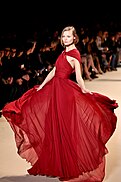




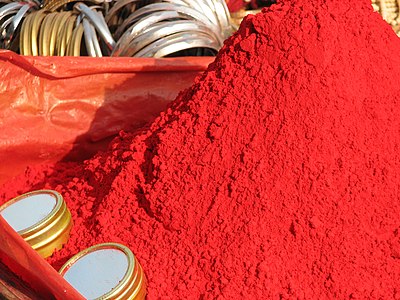


![Maroon is a dark brownish red. Its name comes from marron, the French word for chestnut.[6][7]](http://upload.wikimedia.org/wikipedia/commons/thumb/3/31/Chestnuts02.jpg/368px-Chestnuts02.jpg)
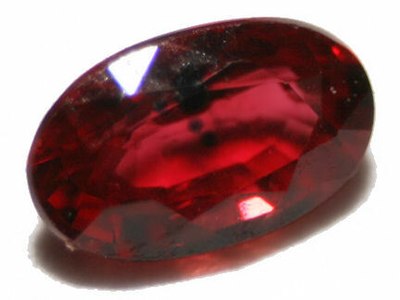

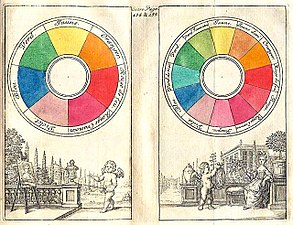
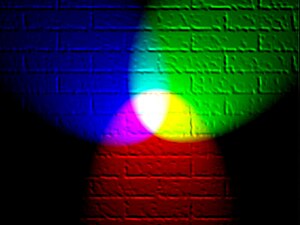




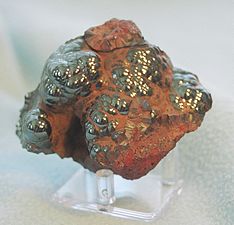



















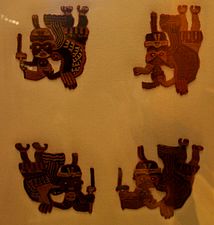
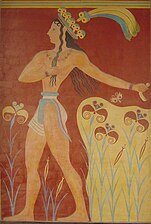


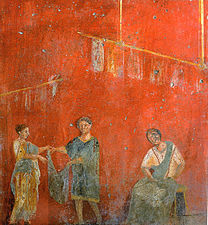













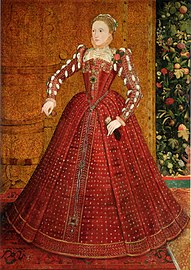

































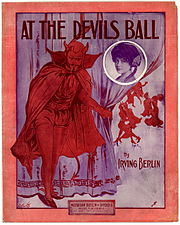
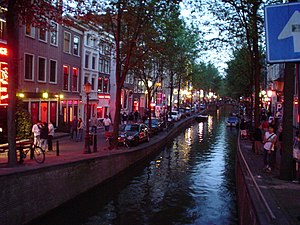

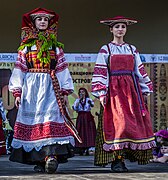

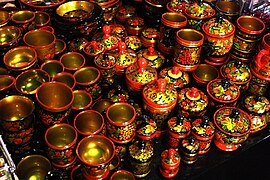
![Russian red boots are worn by men during Russian dances[115]](http://upload.wikimedia.org/wikipedia/commons/thumb/c/c2/Russian_dancer_at_the_Imagine_Cup.jpg/270px-Russian_dancer_at_the_Imagine_Cup.jpg)










